Abstract
Eight new species of Hymenochilus from Australia are described and illustrated. Six of the new species have affinities to (and are here compared with) H. cycnocephalus: H. anemophilus, H. calcicola, H. cymbellus, H. longipes, H. nemoralis and H. pachylus. Hymenochilus anemophilus is shorter (2-8 cm), with dark green strongly veined rosette leaves, crowded dark green flowers, oblong to obovate labellum lamina and, a broader blunter beak on the labellum appendage; H. calcicola is shorter (3-12 cm), crowded green flowers with prominent dark green stripes, ovate petals with a strongly developed basal flange on the anterior side and narrow elliptic labellum lamina with a broad pointed beak on the labellum appendage; H. cymbellus differs by its sparser basal rosette with narrower rosette leaves, thinner scapes, flowers with distinct darker green stripes and shallowly saccate lateral sepals that narrow inwards to a distinctly pointed apex; H. longipes differs by its thin-textured rosette leaves, widely spaced darker green flowers with darker green veins, elliptic-obovate labellum lamina and a longer labellum basal appendage which protrudes prominently from the flower in side view; H. nemoralis has longer rosette leaves, thicker scape and darker green flowers with prominent narrow dark green stripes; H. pachylus has thicker rosette leaves, taller, thicker scape, flowers prominently striped, elliptic-obovate labellum lamina and labellum appendage with a short thick beak. Two of the new species have affinities (and are here compared) with H. muticus: H. pagophilus and H. pisinnus. Hymenochilus pagophilus differs by its moderately crowded to crowded flowers, broader, shinier flowers and rectangular-obovate labellum and H. pisinnus differs by its smaller rosette with smaller, narrower leaves, thinner scape, smaller flowers, that are often on long pedicels, shorter, shallowly saccate lateral sepals, smaller rhomboid petals and, smaller obovate labellum. In addition, Hymenochilus cycnocephalus and H. muticus, are characterised in the strict sense with full descriptions, distribution, and habitat.
Keywords: Arid orchid; Australia; conservation status; Cranichideae; Hymenochilus cycnocephalus; Hymenochilus muticus; Pterostylis; taxonomy
Introduction
Hymenochilus D.L.Jones & M.A.Clem. is a genus of tuberous terrestrial orchids classified in the subtribe Pterostylidinae, tribe Cranichideae. Orchids in Pterostylidinae typically have green to greenish-white flowers with a hooded appearance, due to an inflated dorsal sepal which overlaps the petals to form a galea (hood), which encloses the column. They are often referred to as ‘greenhood orchids’.
Hymenochilus is a genus segregated from the genus Pterostylis (Jones & Clements 2002). Species in Hymenochilus are characterised by having basal, sessile or subsessile, scape-encircling rosette leaves, multiflowered racemes of small, spirally arranged greenish flowers with a short galea, weakly fused, recurved, arcuated, thin-textured lateral sepals, cupped (or rounded inward to a cup shape) towards the base, and with short blunt convergent apices, unlobed, thin-textured labellum lamina with an emarginate apex, vestigial callus and basal appendage more or less at right angles to the lamina, the apical part with thickened margins and a central ridge which can extend as a beak.
Three groups can be distinguished morphologically within Hymenochilus. Group one: Hymenochilus muticus group which is characterised by a pale green or whitish labellum with a darker green recurved oblong appendage which has thickened margins and a short protruding ridge ending below the apex of the appendage. Group two: Hymenochilus cycnocephalus group which is characterised by the labellum appendage arising nearly at right angles to the labellum lamina and bearing a prominently protruding apical beak. Group three: Hymenochilus bicolor group which is characterised by a labellum with swollen dark blackish green appendage recurved at a steep angle and with thickened margins and short blunt protruding ridge ending below the apex of the appendage.
Currently Hymenochilus comprises of 24 species, with 22 species endemic to Australia, most in the south-east, and two species which are endemic in New Zealand (Jones 2008, 2009, 2021). A further eight new species, previously included as ineditus in Jones (2021), are described here, six in the H. cycnocephalus group and two in the H. muticus group. Because of substantial taxonomic changes in the genus, the opportunity is taken to characterise Hymenochilus cycnocephalus and H. muticus in the strict sense with full descriptions, distribution and habitat details.
Materials and Methods
This study is based on the morphological examination of living plants and fresh flowers, examination of dissected flowers mounted on cards, dried and spirit-preserved herbarium specimens and images of living flowers. Herbarium collections, spirit and dried or photographs, were examined from the following herbaria: AD, BRI, BM, CANB, CBG, HO, MEL, NSW and QVM. Protologues were reviewed, including Brown (1810) and Fitzgerald (1876), and descriptions of these (and related) taxa in other sources (e.g., Backhouse 2023, Brown 2022, Copeland & Backhouse 2022, Hoffman et al. 2019, Jones 2021, Neijalke 2022). Descriptions of the new taxa were made from fresh specimens. Drawings were prepared using ink and/or pencil on paper, based on study of living plants and fresh flowers, examination of dissected flowers mounted on cards, dried and spirit-preserved herbarium specimens and images of living flowers. Unless otherwise indicated, all types of Hymenochilus relevant to this study (or photographs thereof) have been seen by the senior author. Measurements given in the descriptions are from living plants or dissected flowers on cards. Notes on distribution, habitat and ecology were derived from the senior author’s own observations, from those of colleagues, or from herbarium labels. Suggestions on conservation status are based on field work, comments from colleagues and publications, and are evaluated using the IUCN Red List categories and criteria (IUCN 2022)
Taxonomic treatment
Hymenochilus anemophilus D.L.Jones, sp. nov. (Fig. 1-2).
TYPE: Australia. South Australia: Mokota Grassland Reserve, 1 km N of Mt Cone, 25 Aug. 2000, R.J.Bates 57244 (holotype, CANB 621066; isotype, AD).
Diagnosis: With affinity to H. cycnocephalus but it differs by its by dwarf habit (2-8 cm tall cf. 8-20 cm tall in H. cycnocephalus), dark green strongly veined rosette leaves (paler green and faintly veined leaves in H. cycnocephalus), crowded dark green flowers (moderately crowded to separated paler green flowers in H. cycnocephalus), oblong to obovate labellum lamina (oblong to elliptic in H. cycnocephalus) and, a broader blunter beak on the labellum appendage (narrower blunt or pointed beak in H. cycnocephalus).
Leaves 5-10; lamina elliptical, 10-25 mm long, 5-12 mm wide, dark green, fleshy, shiny, strongly veined, margins entire, apex acute to apiculate. Scape 2-8 cm tall, 2-3 mm wide, 2-12-flowered. Sterile bracts 1-2, closely sheathing to spreading, elliptic when flattened, 5-11 mm long, 3-5 mm wide, fleshy, acuminate. Fertile bracts similar, closely sheathing. Pedicels 4-7 mm long, straight, slender. Ovaries oblong to elliptic, 3-5 mm long, ca.1.5 mm wide. Flowers porrect, crowded, 8-10 mm long, 4-5 mm wide, pale green, faintly striped. Dorsal sepal 9-11 mm long, 4-6 mm wide, slightly gibbous at the base, shallowly curved for most of its length, abruptly decurved near the apex. Lateral sepals deflexed, shallowly saccate, dorsally gibbous, when flattened 6-7 mm long, 6-7 mm wide, points subacute, ca. 4 mm apart. Petals asymmetrical, more or less ovate, 7-8 mm long, 3.5-4.0 mm wide, translucent green with darker veins, dorsal margin strongly thickened, dark green, with a dorsal gibbosity above the middle, ventral margin smooth. Labellum claw irritable, ligulate, ca.1.6 mm long, ca.1.3 mm wide. Labellum lamina oblong to obovate, 2.2-2.5 mm long, 1.8-2.2 mm wide, green with a dark green basal appendage, membranous, apex emarginate. Basal appendage recurved at right angles, oblong-tapered, 1.0-1.5 mm long, ca.1 mm wide, margins dark green, thickened, central ridge narrow, raised above the margins, dark green, ending in a broad, blunt beak 0.8-1.3 mm long. Callus a thickened, darker green, tapered medial ridge on the labellum lamina. Column obliquely erect, 5-7 mm long, shallowly curved, green with darker areas on the wings. Column wings more or less rectangular, ca. 2.3 mm long, ca.1.3 mm wide, basal lobe deltate, inner margins sparsely ciliate; barrier cilia ca.0.3mm long, clavate. Anther ca.1 mm long, obtuse. Pollinia clavate, ca.1 mm long, yellow, mealy. Stigma central, scutiform, ca. 3 mm long, ca.1.5 mm wide, raised. Capsules not seen.
Distribution and ecology: Restricted to small areas of montane grassland near Mount Bryan and Spalding in the Northern Lofty district of South Australia, between 550-750 m elevation. Grows in bleak situations on high windswept grassy hills in heavy, moisture-retentive red clay loam. Winter snowfalls and strong winds are relatively frequent at these sites (R. Bates pers. comm.).
Flowering: August and September.
Recognition: Hymenochilus anemophilus is characterised by dwarf habit (to 8 cm tall); relatively large, dark green, fleshy, strongly veined rosette leaves; short, thick scape; crowded, pale green flowers with faint darker stripes; deeply saccate lateral sepals; ovate to oblong petals; and an oblong to obovate labellum lamina and labellum appendage with a blunt beak.
Similar species: Compared with Hymenochilus anemophilus, H. cycnocephalus is taller growing, with thinner-textured, paler, faintly veined rosette leaves and broader, moderately crowded to separated, paler green, faintly striped flowers, oblong to elliptic labellum with a narrower, blunt or pointed beak. Hymenochilus calcicola, which grows on limestone, is slightly taller growing (to 12 cm tall) than H. anemophilus with strongly striped flowers and a narrow elliptic labellum lamina and labellum appendage with a broad, pointed beak. Hymenochilus spissus grows to about 12 cm tall and can be distinguished from H. anemifolius by its smaller, paler, faintly striped flowers, shallowly saccate lateral sepals and smaller oblong labellum. Hymenochilus pratensis grows to about 15 cm tall and can be distinguished from H. anemifolius by its broad, almost round, rosette leaves and smaller, boldly striped flowers.
Conservation status: Of restricted distribution but occurring in a conservation reserve. A preliminary extinction risk assessment, based known occurrences of these species, yields an estimated extent of occurrence of 240 km2 and area of occupancy of 28 km2. The species is at risk of continuing decline as a result of the impacts of feral animals and drought on its montane grassland habitat. This indicates that the species may be eligible for listing as Endangered (B1+2ab).
Etymology: From the Greek anemos, wind, and philos, loving, in reference to the bleak windswept habitat where this species grows.
Illustrations: Page 549, Jones (2021); page 238, Niejalke (2022).
Hymenochilus calcicola D.L.Jones, sp. nov. (Fig. 3-4).
TYPE: Australia. South Australia: Belvedere, private property called Wombat Plains, 9 Sep. 1999, D.L.Jones 16800, M.Garratt & J.Eckert (holotype, CANB 606695; isotype, AD).
Diagnosis: With affinity to H. cycnocephalus but it differs by its short habit (3-12 cm tall cf. 8-20 cm tall in H. cycnocephalus), crowded green flowers with prominent dark green stripes (moderately crowded to separated faintly striped flowers in H. cycnocephalus), ovate petals with a strongly developed basal flange on the anterior side (small basal flange in H. cycnocephalus) and narrow elliptic labellum lamina with a broad pointed beak on the labellum appendage (narrower blunt or pointed beak in H. cycnocephalus).
Leaves 5-12; lamina elliptical, 5-22 mm long, 3-12 mm wide, pale green to green, thick, fleshy, dull, veins raised, margins entire or slightly wavy, apex acute to acuminate. Scape 3-12 cm tall, 2-3 mm wide, 3-11-flowered. Sterile bracts 2-4, often in a crowded basal group, closely sheathing to spreading, elliptic when flattened, 5-12 mm long, 3-6 mm wide, thin-textured, acuminate. Fertile bracts similar, closely sheath- ing. Pedicels 3-5 mm long, straight, slender. Ovaries oblong to elliptic, 3-5 mm long, ca.1.5 mm wide. Flowers porrect, crowded, 8-11 mm long, 3.0-4.5 mm wide, green with prominent darker green stripes. Dorsal sepal 7-9 mm long, 4-5 mm wide, very slightly gibbous at the base, shallowly curved for most of its length, abruptly decurved near the apex. Lateral sepals deflexed, deeply saccate, dorsally gibbous, when flattened 4-5 mm long, 4-5 mm wide, points subacute, 2-3 mm apart. Petals asymmetrical, more or less ovate, 6-7 mm long, 3.0-3.5 mm wide, translucent green with darker veins, dorsal margin strongly thickened, dark green, with a dorsal gibbosity above the middle, ventral margin smooth, with a prominent basal flange. Labellum claw irritable, ligulate, ca.1.5 mm long, ca.1.3 mm wide. Labellum lamina elliptic, 2.0-2.3 mm long, 2.4-2.6 mm wide, whitish green with a dark green basal appendage, membranous, apex emarginate. Basal appendage recurved at right angles, oblong-tapered, ca. 1.5 mm long, ca.1 mm wide, margins dark green, thickened, central ridge narrow, weakly raised above the margins, dark green, ending in a broad, pointed beak 1-1.3 mm long. Callus a thickened tapered medial ridge. Column obliquely erect, 6.5-7.5 mm long, shallowly curved, green with darker areas on the wings. Column wings more or less rectangular, ca. 2.3 mm long, ca.1.3 mm wide, basal lobe deltate, inner margins strongly incurved, sparsely ciliate; barrier cilia ca. 0.4 mm long, clavate. Anther ca.1 mm long, obtuse. Pollinia oblong-clavate, ca.1 mm long, yellow, mealy. Stigma central, elliptical, ca. 3 mm long, ca.1.3 mm wide, raised. Capsules 5-7 mm long, 3-4 mm wide, on pedicels to 6 mm long. Capsules not seen.
Distribution and ecology: Occurs in western Victoria and the Murray district of South Australia (where widespread and common), the Southern Lofty district and on Yorke Peninsula, between 30-180 m of elevation. Grows in mallee woodland, Callitris woodland, mallee-broombush association, shrubland, and bare open areas along with sparse tussocks of Lomandra Labill. and Lepidosperma Labill. The common factor seems to be limestone in the soil profile either subterranean or as outcrops and pavements, with the soils being sands and terra rossa.
Flowering: July to September.
Recognition: Hymenochilus calcicola is characterised by short habit (to 12 cm tall); pale green to green, thick, fleshy, dull rosette leaves with raised veins; thickish scape; crowded green flowers with prominent dark green stripes; deeply saccate lateral sepals; ovate petals with a strongly developed basal flange on the anterior side; and narrow elliptic labellum lamina with a broad pointed beak on the basal appendage.
Similar species: Hymenochilus cycnocephalus is taller growing than H. calcicola (to 20 cm tall) with a thinner scape, less crowded paler green flowers with inconspicuous stripes, narrower petals without a prominent basal flange and an elliptical labellum with a narrower blunt or pointed beak on the basal appendage. Hymenochilus anemifolius is even shorter growing than H. calcicola (to 8 cm tall), and has dark green, fleshy, strongly veined rosette leaves, crowded but less conspicuously striped flowers, an obovate labellum and labellum appendage with a broad blunt beak. Hymenochilus spissus grows to about 12 cm tall and can be distinguished from H. calcicola by its smaller, paler, faintly striped flowers, shallowly saccate lateral sepals and smaller oblong labellum. Hymenochilus pratensis grows to about 15 cm tall and can be distinguished from H. calcicola by its broad, almost round, rosette leaves and smaller, boldly striped flowers.
Notes: The leaves of Hymenochilus calcicola are generally extant at flowering time. This species exhibits variation that may warrant further study. Some populations have a condensed inflorescence with the lowermost flowers opening while still partly enclosed by the sterile bracts and after anthesis the inflorescence ends up no more than 5-7 cm tall (for example R.Bates 20422 from the Woodchester area [CANB 631710]). Most collections do not exhibit this extreme growth habit and this dwarfism may be an adaptation to highly exposed sites. Some specimens with a very thin scape (e.g. North Wolseley, D.Hunt s.n. (AD)) may warrant further investigation. A collection from Cherry Gardens (Herb. R.S.Rogers 4044) has unusually large foliose bracts.
Conservation status: This species has a widespread distribution, including within protected areas, with estimated extent of occurrence 65,000 km2 and a population size of >10,000 individuals. There is no known evidence of continuing decline. A preliminary extinction risk assessment based on known occurrences of, and threats to, results in a classification of this species as least concern.
Etymology: From the Latin calci for lime or limestone, and cola a dweller, in reference to the typical habitat of the species.
Specimens examined: VICTORIA: Bats Ridges, Portland, Oct. 1948, A.C.Beauglehole 4845 (MEL); Terrick Terrick State Park, 4 Sep. 1985, A.C.Beauglehole 80022 (MEL); Kiata Flora Reserve, 14 Sep. 1986, A.C.Beauglehole 84382 (MEL); reserve just S of old Kiata school, 19 Sep. 1990, D.L.Jones 6567 & C.H.Broers (CANB). SOUTH AUSTRALIA: Monarto, 14 Sep. 1976, C.R.Alcock 5422 (AD); Woodchester area, 3 Sep. 1989, R.Bates 20422 (CANB); Chilton Scrub, Langhorne Creek, 6 Aug. 2000, R.Bates 57151 (CANB); Melton South, 13 Aug. 2000, R.Bates 57194 (CANB); Monarto New Town area, 4 Sep. 1974, J.Carrick 3589 (AD); 15 km W of Murray Bridge, 1 Oct. 1974, J.Carrick 4713 (AD); Kinchina, 17 Sep. 1927, J.B.Cleland (AD); Middle Yorke Peninsula, 2 Oct. 1957, Hj. Eichler 14226 (AD); Mt Monster, 26 Aug. 1969, D.Foster (CANB); Brinkley Station, 22 Sep. 1967, N.Gemmell (AD); Murray Bridge, Oct. 1943, H.Goldsack (AD); Monarto South, Oct. 1950, H.Goldsack (AD); near Milang, 5 Sep. 1966, D.Hunt 2669 (AD); Monarto South, 28 Aug. 1919, E.H.Ising (AD); Tailem Bend Forest Reserve, 31 Aug. 1999, D.L.Jones 16563 & M.Garratt (CANB); Monarto Conservation Park, 31 Aug. 1999, D.L.Jones 16569 & M.Garratt (CANB); Hartley, 9 Sep. 1999, D.L.Jones 16805, M.Garratt & J.Eckert (CANB); Monarto, 1 Sep. 1897, M.Menzel (AD, NSW); 3 km S of Hartley on Langhorne Creek, 2 Sep. 1967, R.C.A.Nash (AD); Wolseley, Sep. 1943, K.Ridgeway 668 (AD); Monarto, Sep. 1906, R.S.Rogers (NSW); Monarto South, 3 Oct. 1906, R.S.Rogers (AD, NSW); Monarto, 15 Sep. 1917, R.S.Rogers (AD); Kinchina, 17 Sep. 1927, R.S.Rogers (AD); Cooke Plains, 18 Aug. 1960, M.C.R.Sharrad 720 (AD); Braendlers Scrub near Monarto South, 3 Sep. 1978, P.Short 730 (AD); Sanderston, 29 Sep. 1968, T.J.Smith 2275 (AD); near Tailem Bend, 1 Sep. 1967, J.Warcup (AD); Chaunceys Line, 4 km SE of Hartley, 6 Sep. 1958, D.J.Whibley 216 (AD).
Illustrations: Page 549, Jones (2021); page 239, Niejalke (2022); page 242, Backhouse (2023), where it is labelled Pterostylis calcicola.
Hymenochilus cycnocephalus (Fitzg.) D.L. Jones & M.A.Clem., Austral. Orch. Res. 4: 74 (2002); Pterostylis cycnocephala Fitzg., Austral. Orch. 1(2): t.7 (1876). (Fig. 5-6).
TYPE: Australia. New South Wales: Molong, Dr. Ross (lectotype, BM [BM000048410], specimen (a), fide Clements 1989, photo!). Residual syntype, Boorowa, G.H.Sheaffe s.n. (not seen).
Leaves 5-9; lamina ovate to elliptical, 5-25 mm long, 3-15 mm wide, green, fleshy, dull; margins entire or slightly wavy; apex acute to apiculate. Scape 8-20 cm tall, 2-3 mm across, 3-12-flowered. Sterile bracts 2-4, closely sheathing, ovate to elliptic, 5-12 mm long, 3-5 mm wide, thin-textured, acuminate. Fertile bracts similar, closely sheathing the pedicel. Pedicels 3-5 mm long, straight, slender, mostly hidden within the bract. Ovaries oblong to elliptic, 3-5 mm long, ca. 1.5 mm wide. Flowers porrect, moderately crowded to separated, 8-10 mm long, ca. 3-4 mm wide, translucent green with faint darker green stripes.
Dorsal sepal 7-9 mm long, 4-5 mm wide, very slightly gibbous at the base, shallowly curved for most of its length, abruptly decurved near the apex. Lateral sepals deflexed, deeply saccate, dorsally gibbous, when flattened 6-7 mm long, 5-6 mm wide, points subacute, 3-4 mm apart. Petals asymmetrical, more or less ovate, 5.5-7.0 mm long, 3.0-3.5 mm wide, translucent green with darker veins, dorsal margin strongly thickened, dark green, a dorsal gibbosity above the middle, ventral margin smooth. Labellum claw irritable, ligulate, ca. 1.2 mm long, ca. 1 mm wide. Labellum lamina oblong to elliptic, 2.0-2.3 mm long, 2.0-2.2 mm wide, whitish green with a dark green appendage, membranous, apex emarginate. Basal appendage recurved at an acute angle, oblong-tapered, ca. 1.5 mm long, ca. 0.8 mm wide, margins dark green, thickened; central ridge narrow, raised weakly above the margins, dark green, ending in a narrow, blunt or pointed beak ca. 1 mm long. Callus a shallowly thickened, tapered medial ridge on the labellum lamina. Column obliquely erect, 6-7 mm long, shallowly curved, green with darker areas on the wings. Column wings more or less rectangular, ca. 2.3 mm long, ca. 1.3 mm wide, basal lobe deltate, inner margins strongly incurved, sparsely ciliate; barrier cilia ca. 0.4 mm long, clavate. Anther ca.1 mm long, obtuse. Pollinia clavate, ca. 1 mm long, yellow, mealy. Stigma central, elliptical, ca. 2 mm long, ca. 1.3 mm wide, raised. Capsules oblong elliptic, 5-8 mm long, 3-4 mm wide, on pedicels to 6 mm long.
Distribution and ecology: Occurs in New South Wales (from the Northern Tablelands to Wagga Wagga), Australian Capital Territory and Victoria (mainly north and central, from east to west), between 50-800 m of elevation. However, its exact range needs confirmation (see Notes). Although occurring in coastal districts, its main occurrence is to be found in ranges well inland from the coast, extending to the inland plains. Grows in open forest, woodland, shrubland and grassland in shallow, well-drained to moisture-retentive clay loam and sandy loam.
Flowering: September to November.
Recognition: Hymenochilus cycnocephalus is characterised by relatively large, faintly veined rosette leaves (to 25 × 15 mm); moderately tall, slender scape (to 20 × 0.3 cm); relatively large, moderately crowded to separated translucent green flowers (to 10 × 4 mm) with faint darker green stripes; deeply saccate lateral sepals; relatively broad ovate petals without an obviously expanded basal area; and, an oblong to elliptic labellum with a narrow blunt or pointed beak.
Similar species: The morphology of Hymenochilus cycnocephalus is similar to the following species described as new species in this paper: Hymenochilus nemoralis, which has larger rosette leaves (to 40 × 15 mm) and thicker scapes than H. cycnocephalus with more numerous relatively crowded to well-spaced flowers, deeply saccate lateral sepals and an oblong labellum lamina with a short labellum appendage and narrow beak; Hymenochilus cymbellus¸ differs from H. cycnocephalus by its smaller, sparse rosette leaves, thinner scapes, narrower striped flowers and shallowly saccate lateral sepals that narrow inwards to a distinctly pointed apex; Hymenochilus pachylus, which has larger crowded, fleshier rosette leaves than H. cycnocephalus, thicker scape, widely spaced darker green flowers with darker green veins and broadly obovate labellum with a short broad appendage with a thick beak; Hymenochilus longipes, which has larger rosette leaves than H. cycnocephalus, slender scape and broader, less prominently striped flowers with a longer stalk on the labellum appendage which can be seen protruding prominently from the flower in sideview.
Hymenochilus anemophilus and H. calcicola, both also described as new in this paper, H. pratensis (D.L.Jones) D.L.Jones & M.A.Clem. from the Central Highlands of Tasmania and H. spissus D.L.Jones from basalt outcrops in central-western Victoria can all be distinguished from H. cycnocephalus by shorter habit and densely crowded flowers. Also, Hymenochilus crassicaulis D.L.Jones & M.A.Clem. from subalpine areas in south-eastern New South Wales, Australian Capital Territory and north-eastern Victoria is more robust than H. cycnocephalus with greyish rosette leaves, thicker scapes and larger crowded bluish-green and white flowers with a large beak on the labellum appendage.
Notes: The exact range of H. cycnocephalus is uncertain, and the following observations are pertinent and may assist future research. Plants from the Northern Tablelands of New South Wales are very similar to typical H. cycnocephalus but tend to have an obovate labellum and a basal appendage with a shallow beak about 0.3 mm deep. Plants from rain shadow sites in high montane areas in the Australian Capital Territory, southern New South Wales, and north-eastern Victoria (Cravensville, Wulgulmerang) grow taller than H cycnocephalus from lower sites, have relatively small flowers and a prominent flange-like extension on the petal base. The labellum beak, however, is a good match for that of typical H. cycnocephalus. Plants from western Victoria and south-eastern South Australia (e.g. Mt Boothby, R.Bates (AD)) have pale green flowers with fairly prominent darker green stripes and a relatively larger labellum appendage. These approach H. nemoralis, but in the absence of fresh material I am uncertain if they are conspecific.
Conservation status: This species has a widespread distribution, including in protected areas, with estimated extent of occurrence 326,000 km2, area of occupancy of 980 km2, a population size of >10,000. There is no known evidence of continuing decline. A preliminary extinction risk assessment based on known occurrences of, and threats to, this species places it in the least concern category.
Specimens examined: NEW SOUTH WALES: Store Creek, between Orange and Wellington, Sep. 1950, P.Althofer (NSW); Warrumbungles, Nov. 1982, R.Bates 2808 (AD); Ungarie, 6 Oct. 1987, R.Bates 10459 (AD); Ebor, 22 Nov. 1987, R.Bates 12861 (AD); Cooma, 29 Nov. 1987, R.Bates (AD); Peak Hill, Oct. 1906, J.L.Boorman (NSW); Rylstone, 4 Nov. 1962, W.Brinsley (CANB); Tooloom, 9 Sep. 1911, R.H.Cambage (NSW); Bumberry, 2 Oct. 1916, H.Cleland (AD); 10 km S of Ardlethan, 29 Sep. 1985, M.A.Clements 3786 (CANB); Mt Jerrabomberra, 14 Oct. 1985, M.A.Clements 3874 (CANB); 200 m N of Moonbi Lookout, 9 Oct. 2004, L.M.Copeland 3807 (CANB); 1.25 km S of Mt Jerrabomber- ra, 24 Oct. 1997, I.Crawford 4511 (CANB); Moonbi Range, 1 Oct. 1984, M.D.Crisp 7399a & I.R.Telford (CANB); Abercrombie Caves, 2 Oct. 1955, H.Curnow & A.W.Dockrill (AD); Mudgee, Oct. 1881, H.Deane (NSW); 8 km E of Ardlethan, 10 Sep. 1988, D.L.Jones 2796 & M.A.Clements (CANB); Narranderra Range, 10 Sep. 1988, D.L.Jones 2809 (CANB); Sims Gap, 20 Sep. 1990, D.L.Jones 6579 & C.H.Broers (CANB); 9.2 km E of Weethalle, 20 Sep. 1990, D.L.Jones 6584 & C.H.Broers (CANB); ca. 32.8 km W of West Wyalong, 22 Oct. 1992, D.L.Jones 10448 & C.H.Broers (CANB); Buckinbong State Forest, 26 Sep. 2000, D.L.Jones 17522 & K.J.FitzGerald (CANB); Quarry, 8 km N of Rankin Springs, 28 Sep. 2000, D.L.Jones 17560 & K.J.FitzGerald (CANB); 9.1 km E of Weethalle towards West Wyalong, 28 Sep. 2000, D.L.Jones 17570 & K.J.FitzGerald (CANB); Bookham, 16 Oct. 1992, D.L.Jones 17877 (CANB); Yarranjerry State Forest, 18 Sep. 2005, D.L.Jones 19248 & B.E.Jones (CANB); Wahgunyah State Forest, 29 Sep. 2005, D.L.Jones 19282 & M.A.Clements (CANB); Rifle Range, East Goulbourn, Oct. 1906, J.Lumsden (NSW); Thredbo River (in fruit), Jan. 1899, J.H.Maiden & W.Forsyth (NSW); Tea-tree Creek, Bundarra, Oct. 1968, I.G.Matthias (CANB); Ginninderra Falls, 15 Oct. 1960, H.S.McKee 7449 (CANB); 8 km SW of Dubbo, 13 Sep. 1973, T.B.Muir 5122 (CANB); Gulpa Forest, 25 km S of Deniliquin, 9 Oct. 1978, W.E.Mulham (NSW); Koorawatha Falls, 5 Oct. 2002, R.W.Purdie 5585 (CANB); Alum Mountain, Bulahdelah, July 1924, H.M.R.Rupp (NSW); Escort Rock, 5 Oct. 1963, B.Whitehead (CANB); Crackerjack Mountain, 26 Oct. 1963, B.Whitehead (CANB); Kangarooby, 26 Sep. 1964, B.Whitehead (CANB). AUSTRALIAN CAPITAL TERRITORY: Upper Orroral Valley, 4 Nov. 1960, N.T.Burbidge 6670 (CANB); Rendezvous Creek, Gudgenby Road, 1 Nov. 1961, N.T.Burbidge 7226 (CANB); Canberra Airport, 26 Oct. 1995, I.Crawford 3258 (CANB); Kambah, 20 Sep. 1983, F.Davies 69 & I.R.Telford (CANB); Black Mountain, 16 Oct. 1964, M.Gray 5556 (CANB); Gungahlin Hill Nature Reserve, 24 Oct. 1995, D.L.Jones 14559 & B.E.Jones (CANB); Majura Firing Range, 19 Oct. 1998, D.L.Jones 15887, M.A.Clements & P.Downey (CANB); track to Nursery Swamp, 8 Nov. 1999, D.L.Jones 17018 & M.Garratt (CANB); Naas River Valley Fire Trail, 8 Dec. 1998, D.L.Jones 16263 & M.Garratt (CANB, MEL, NSW); 6 km S of Tharwa, 8 Nov. 1999, D.L.Jones 17031 & M.Garratt (CANB); SW side of Black Mountain, 29 Oct. 2005, D.L.Jones 19334 (CANB); between O’Malley and Mt Mugga, 20 Oct. 1991, D.Mallinson 148 (CANB); 1 km E of Vanitys Crossing, 2 Nov. 1992, D.Mallinson 274 (CANB); W slope of Black Mountain, 28 Oct. 1962, H.S.McKee 9644 (CANB); Belconnen Naval Radio Station, Lawson, 15 Oct. 1998, M.E.Nightingale (ORG 1624) (CANB). VICTORIA: Mordialloc, 2 Aug. 1900, W.R.Baker (MEL); Barrabool Flora and Fauna Reserve, 17 Oct. 1986, A.C.Beauglehole 82717 (MEL); Boyeo Flora Reserve, 12 Sep. 1986, A.C.Beauglehole 84240 (MEL); West Wail Flora and Fauna Reserve, 15 Oct. 1986, A.C.Beauglehole 86187 (MEL); Dandenong Ranges, Nov. 1925, A.B.Braine (CANB); near Corryong, 31 Oct. 2004, P.G.Branwhite 253 (CANB); Healesville, 28 Sep. 1921, D.Coleman (AD); Mt Piper, 6 Oct. 1912, C.French jr. (AD); Lyndhurst South, Dec. 1920, A.C.Gates (MEL); Deddick, Oct. 1941, W.Hunter (NSW); Stawell Rifle Range Reserve, 18 Sep. 1990, D.L.Jones 6527 & C.H.Broers (CANB); Kanga, Sep. 1941, J.Leppitt 670 (AD); Greensborough, Sep. 1941, J.Leppitt 702 (AD); Greensborough, Sep. 1925, W.H.Nicholls (NSW); Ringwood, 9 Sep. 1915, E.E.Pescott (AD); Sale, Oct. 1899, no collector (NSW).
Illustrations: Page 550, Jones (2021); page 345, Copeland & Backhouse (2022); page 240, Backhouse (2023), both as Pterostylis cycnocephala.
Hymenochilus cymbellus D.L.Jones, sp. nov. (Fig. 7-8).
TYPE: Australia. South Australia: 1.4 km along track E of Mangalo-Cowell road towards “Pootitnee” property, 6 Sep. 2000, D.L.Jones 17348 & M.Garratt (holotype, CANB 622384; isotypes: AD, MEL-2371227A).
Diagnosis: With an affinity to H. cycnocephalus, but it differs by its sparser basal rosette with narrower rosette leaves (to 10 mm wide cf. 15 mm wide in H. cycnocephalus), thinner scapes (0.5-1.5 mm wide cf. 2-3 mm wide in H. cycnocephalus), flowers with distinct darker green stripes (faintly striped flowers in H. cycnocephalus) and shallowly saccate lateral sepals that narrow inwards to a distinctly pointed apex (deeply saccate lateral sepals with subacute apex in H. cycnocephalus).
Leaves 3-10; lamina ovate to elliptical, 7-25 mm long, 4-10 mm wide, green, thin-textured, dull, margins entire, apex acute to acuminate or apiculate. Scape 2-12 cm tall, 0.5-1.5 mm across, 1-8-flowered. Sterile bracts 2-4, closely sheathing to spreading, elliptic when flattened, 3-8 mm long, 1.5-4 mm wide, thin-textured, acuminate. Fertile bracts similar, closely sheathing. Pedicels 2-4 mm long, straight, slender. Ovaries oblong to elliptic, 2-4 mm long, ca. 1.5 mm wide. Flowers porrect, relatively crowded to well-spaced, 6-9 mm long, 3-4 mm wide, green with conspicuous narrow darker green stripes. Dorsal sepal 7-8 mm long, 4-5 mm wide, slightly gibbous at the base, shallowly curved for most of its length, abruptly decurved near the apex. Lateral sepals deflexed, shallowly saccate, dorsally gibbous, the apex pointed, when flattened 4-5 mm long, 4-5 mm wide, points subacute, 2-3 mm apart. Petals asymmetrical, more or less ovate, 5.0-5.5 mm long, 3.0-3.5 mm wide, translucent green with darker veins, dorsal margin strongly thickened, dark green, a dorsal gibbosity above the middle, ventral margin smooth or weakly irregular. Labellum claw irritable, ligulate, ca. 1.3 mm long, ca.1 mm wide. Labellum lamina elliptic-obovate, 2.2-2.5 mm long, 1.8-2.2 mm wide, whitish green with a dark green basal appendage, membranous, apex emarginate. Basal appendage recurved at right angles, oblong, ca. 1.5 mm long, ca. 1 mm wide, margins dark green, thickened, central ridge narrow, raised above the margins, dark green, ending in a broad, blunt beak 0.8-1.0 mm long. Callus a thickened tapered medial ridge. Column obliquely erect, 7-8 mm long, shallowly curved, green with darker areas on the wings. Column wings more or less rectangular, ca. 2 mm long, ca.1 mm wide, basal lobe deltate; inner margins strongly incurved, sparsely ciliate; barrier cilia ca. 0.4 mm long, clavate. Anther ca.1 mm long, obtuse. Pollinia clavate, ca.1 mm long, yellow, mealy. Stigma central, elliptical, ca. 2.5 mm long, ca. 1.3 mm wide, raised. Capsules 6-8 mm long, 3-4 mm wide, on pedicels to 10 mm long.
Distribution and ecology: Known from the Eyre Peninsula in South Australia, between 50-350 m elevation. However, its exact range is uncertain. It may also occur in the Gawler Ranges. Grows on and around the margins of acidic rock outcrops; also, in shrubland, especially with broombush, in red-brown loam developed on acid schistose rocks, and among Triodia R.Br. clumps in relatively open sites.
Flowering: July to September.
Recognition: Hymenochilus cymbellus is characterised by small, sparse rosettes with narrow leaves, thin scapes, relatively crowded to well-spaced, narrow, conspicuously striped flowers, shallowly saccate lateral sepals that narrow inwards to a distinctly pointed apex, ovate petals, elliptic-obovate labellum, and labellum basal appendage with a broad, blunt beak.
Similar species: Hymenochilus cycnocephalus has more numerous and generally larger rosette leaves than H. cymbellus, darker green flowers with inconspicuous stripes, deeply saccate lateral sepals ending in a broad, blunt apex and an elliptical labellum with a broader beak on the basal appendage. Compared to H. cymbellus, H. nemoralis has relatively large rosette leaves, thicker scapes with more numerous relatively crowded to well-spaced flowers, deeply pouched blunt lateral sepals and an oblong labellum lamina with a short labellum appendage and narrow beak-like structure. Hymenochilus pachylus has larger crowded, fleshier rosette leaves than H. cymbellus, thicker scape, well-spaced flowers, and broadly obovate labellum with a short broad appendage. Hymenochilus longipes has larger rosette leaves than H. cymbellus, slender scape and broader, less prominently striped flowers with a longer stalk on the labellum appendage. Hymenochilus crassicaulis is more robust than H. cymbellus with greyish rosette leaves, thicker scapes, and larger crowded bluish-green and white flowers with a large beak on the labellum appendage. Hymenochilus anemophilus, H. calcicola, H. pratensis and H. spissus can all be distinguished from H. cymbellus by their densely crowded flowers.
Notes: The leaves of this species can either be extant or withered at flowering time.
Conservation status: A preliminary extinction risk assessment, based known occurrences of these species, yields an estimated extent of occurrence of 11,800 km2. The species is at risk of continuing decline as a result of climate change, particularly the effect increased frequency and severity of drought, and increased temperatures on this species habitat. This indicates that the species may be eligible for listing as Vulnerable (B1+2ab).
Etymology: From the Latin cymbella, small boat, in reference to the shape of the lateral sepals.
Specimens examined: SOUTH AUSTRALIA: Curtinye Hill, NE of Kimba, 28 Aug. 1983, R.Bates 3309 (AD); Stamford Hill, 18 July 1994, R.Bates 37129 (CANB); E of Coolanie Hall, 5 Sep. 2000, D.L.Jones 17329 & M.Garratt (AD, CANB, MEL); Carrapee Hill, 6 Sep. 2000, D.L.Jones 17379 & M.Garratt (CANB); Carrapee Hill, 14 Sep. 1974, F.A.Mason 296 (AD); Hincks Natl. Park, 7 Oct. 1968, R.C.A.Nash (AD); Hincks Natl. Park, 7 Oct. 1968, J.R.Wheeler 776 (AD).
Illustrations: Page 550, Jones (2021); page 240, Niejalke (2022).
Hymenochilus longipes D.L.Jones, sp. nov. (Fig. 9-10).
TYPE: Australia. Queensland: “Nabwood”, Stanthorpe, Inglewood Road (private property), 18 Sep. 1996, R.Crane 1624 (holotype, CBG-9708281).
Diagnosis: With affinity to H. cycnocephalus, but it differs by its thin-textured rosette leaves (thicker and fleshier in H. cycnocephalus), widely spaced darker green flowers with darker green veins (flowers translucent with faint veins in H. cycnocephalus), elliptic to obovate labellum lamina (oblong to elliptic in H. cycnocephalus) and a longer labellum basal append- age which protrudes prominently from the flower in side view (labellum basal appendage does not protrude prominently in H. cycnocephalus).
Leaves 5-8; lamina elliptical, 10-25 mm long, 5-12 mm wide, green, thin-textured, margins entire, apex acute to apiculate. Scape 10-28 cm tall, 1.5-2.5 mm across, 5-12-flowered. Sterile bracts 4-6, closely sheathing, oblong to elliptic when flattened, 5-15 mm long, 4-6 mm wide, acuminate. Fertile bracts similar, closely sheathing. Pedicels ca. 4 mm long, straight, slender. Ovaries oblong to elliptic, 3-4 mm long, ca.1.5 mm wide. Flowers porrect, widely spaced, 8-9 mm long, ca. 3-4 mm wide, green with darker green veins. Dorsal sepal 7-9 mm long, 4-6 mm wide, slightly gibbous at the base, nearly straight or shallowly curved for most of its length, abruptly decurved near the apex. Lateral sepals deflexed, deeply saccate, dorsally gibbous, when flattened 4.0-5.5 mm long, 4.0-4.5 mm wide, points subacute, ca. 3 mm apart. Petals asymmetrical, more or less ovate-oblong, 6-7 mm long, 2.5-3.0 mm wide, green with darker green veins, dorsal margin strongly thickened, dark green, with a dorsal gibbosity just above the middle, ventral margin irregular. Labellum claw irritable, ligulate, ca.1 mm long, ca. 0.6 mm wide. Labellum lamina elliptic to obovate, 2.0-2.3 mm long, 1.8-2.0 mm wide, whitish green with a dark green appendage, membranous, apex emarginate. Basal appendage sharply recurved, on a long stalk and protruding from the flower in sideview, narrowly oblong, 1.5-2 mm long, ca. 0.8 mm wide, margins dark green, thickened, central ridge narrow, raised above the margins, dark green, ending in a broad, bluntish blunt beak 0.8-1 mm long. Callus a thickened, darker green, tapered medial ridge. Column obliquely erect, 6-8 mm long, shallowly curved, green with darker areas on the wings. Column wings more or less rectangular, ca. 2 mm long, ca.1 mm wide, basal lobe deltate, inner margins sparsely ciliate; barrier cilia ca. 0.2 mm long, clavate. Anther ca.1 mm long, obtuse. Pollinia clavate, ca.1 mm long, yellow, mealy. Stigma central, scutiform, ca. 2 mm long, ca.1.2 mm wide, raised. Capsules obovoid, 5-6 mm long, ca. 3 mm wide, green to brown, on pedicels to 5 mm long.
Distribution and ecology: Occurs in the Darling Downs district of southern Queensland and Northern Tablelands of New South Wales, between 200-400 m in elevation. Grows in open woodland among granite rocks and in Callitris Vent. woodland, in well-drained brown to yellowish sand.
Flowering: Late August to November.
Recognition: Hymenochilus longipes is characterised by relatively small, green, thin-textured rosette leaves; thin scape; widely spaced, narrow green flowers with darker green veins; relatively small, deeply saccate lateral sepals; ovate-oblong petals; elliptic-obovate labellum lamina and, a long-stalked narrow labellum appendage protruding well out from the flower in sideview with a short, broad bluntish terminal beak.
Similar species: Hymenochilus cycnocephalus has larger fleshy rosette leaves, broader paler, faintly striped flowers than H. longipes, and a shortly stalked labellum appendage held all or mostly within the flower and with a longer, narrower pointed terminal beak. Hymenochilus pachylus has thicker-textured rosette leaves than H. longipes, broader flowers and a shorter stalk on the labellum appendage. Hymenochilus nemoralis has larger rosette leaves than H. longipes and larger, boldly striped flowers. Hymenochilus cymbellus has smaller, sparser rosette leaves than H. longipes, slender scape and narrower, prominently striped flowers with a broad beak on the labellum appendage. Hymenochilus crassicaulis is more robust than H. longipes with greyish rosette leaves, thicker scapes and larger, crowded bluish-green and white flowers with a large beak on the labellum appendage. Hymenochilus anemophilus, H. calcicola, H. pratensis and H. spissus can all be distinguished from H. longipes by their densely crowded flowers.
Notes: The leaves of this species are usually withered at flowering time.
Conservation status: This species has a widespread distribution, including within protected areas, with estimated extent of occurrence 46,000 km2 a population size estimated to be >10,000. There is no known evidence of continuing decline. A preliminary extinction risk assessment based on known occurrences of, and threats to, results in a classification of this species as least concern.
Etymology: From the Latin longus, long, pes, pedis, foot, in reference to the long appendage on the labellum that projects conspicuously out from the lateral sepals in the set position.
Specimens examined: Hill 2 km E of Acland, 14 Sep. 1992, R.Crane 836 (CANB); “Nabwood”, Stanthorpe, Inglewood Road (private property), 22 Sep. 1995, R.Crane 1439 (CANB); ibid, 18 Sep. 1996, R.Crane 1622 (CANB); ibid, 18 Sep. 1996, R.Crane 1624 (CANB); Murphys Creek, Glen Aplin, 20 Oct. 1996, R.Crane 1743 (CANB); Girraween National Park, 11 Nov. 1996, R.Crane 1763 (CANB).
Illustrations: Page 551, Jones (2021).
Hymenochilus muticus (R.Br.) D.L. Jones & M.A.Clem., Austral. Orch. Res. 4: 74 (2002); Pterostylis mutica R.Br., Prodr. 328 (1810). (Fig. 11-12).
TYPE: Australia. New South Wales: Port Jackson, raceground, Sep.-Oct. 1803, R. Brown s.n. (first-step lectotypification: BM, fide George (1971); second-step lectotypification: BM [BM000048248], specimen (a), fide Clements 1989, photo!; isolectotypes, BM [BM-000990303] specimen (a)!, K[K 00061957] specimen (c)!).
Leaves 5-12; lamina ovate to elliptical, 10-45 mm long, 5-18 mm wide, green, fleshy, dull, margins entire or slightly wavy, apex acute to apiculate. Scape 12-35 cm tall, 2-4 mm across, 3-22-flowered. Sterile bracts 3-5, closely sheathing, ovate to elliptic when flattened, 5-16 mm long, 3-6 mm wide, thin-textured, acuminate. Fertile bracts similar, closely sheathing. Pedicels 3-5 mm long, straight, slender. Ovaries oblong to elliptic, 3-5 mm long, ca.1.5 mm wide. Flowers porrect, widely spaced, 10-14 mm long, 3-4.5 mm wide, translucent green with faint darker green stripes. Dorsal sepal 9-12 mm long, 5-7 mm wide, porrect from the ovary at the base, shallowly curved for most of its length, abruptly decurved near the apex. Lateral sepals obliquely deflexed to deflexed, deeply saccate, dorsally curved, when flattened 6-7 mm long, 7-9 mm wide, points subacute, 5-7 mm apart. Petals asymmetrical, more or less ovate-elliptic to rhomboid, 7.0-9.5 mm long, 3.5-4.5 mm wide, translucent green with darker veins, dorsal margin strongly thickened, dark green, a dorsal gibbosity above the middle, ventral margin with beaded siliceous cells. Labellum claw irritable, ligulate, ca. 2 mm long, ca.1 mm wide. Labellum lamina oblong to elliptic, 2.5-3.0 mm long, 2.5-3 mm wide, whitish green with a dark green basal appendage, membranous, apex emarginate. Basal appendage recurved nearly at right angles to lamina, oblong to oblong-tapered, ca. 2.2 mm long, ca.1.3 mm wide, margins green, thickened, central ridge narrow, raised above the margins, dark green, ending below the apex of the appendage. Callus a thickened, tapered, channelled medial ridge. Column obliquely erect, 6.5-7.0 mm long, shallowly curved, green with darker areas on the wings. Column wings more or less rectangular, ca. 3 mm long, ca.1.5 mm wide, basal lobe ovate to deltate, inner margins incurved, sparsely ciliate; barrier cilia ca. 0.4 mm long, linear-clavate. Anther ca.1.2 mm long, obtuse. Pollinia clavate, ca.1 mm long, yellow, mealy. Stigma central, elliptical, ca. 3.5 mm long, ca.1.2 mm wide, raised. Capsules 5-8 mm long, 3-4 mm wide, on pedicels to 10 mm long.
Distribution and ecology: This species occurs in Queensland (Mt Moffat, Canarvon Range to Stanthorpe, coast near Noosa), New South Wales (widespread inland, Tenterfield to Narranderra, Albury, inland to Brewarrina) Australian Capital Territory, and Victoria (east to west, mainly inland areas), between 10-900 m in elevation. Although the type collection was made from Port Jackson, its main occurrence is in areas well inland from the coast. It grows in open forest, woodland, especially Callitris woodland, rocky slopes, rock outcrops and grassland in shallow well-drained to moisture-retentive clay loam and sandy loam.
Flowering: August to November.
Recognition: Hymenochilus muticus is characterised by relatively large, fleshy rosette leaves (to 45 × 18 mm); tall, sturdy scape (to ca. 35 × 0.4 cm); widely spaced translucent green flowers, to 14.0 × 4.5 mm, with faint darker green stripes; deeply saccate lateral sepals; relatively broad ovate-elliptic to rhomboid petals; oblong to elliptical labellum lamina to 3 × 3 mm; and labellum basal appendage with a short, protruding central ridge ending well below the top of the appendage.
Similar species: Hymenochilus pagophilus has a slightly thicker scape than H. muticus, moderately crowded to crowded, broader, shinier flowers, and a rectangular-obovate labellum. Hymenochilus pisinnus has fewer and smaller rosette leaves than H. muticus, thinner flower stem and smaller flowers with shallowly saccate lateral sepals and a smaller obovate labellum. Hymenochilus confertus D.L.Jones, H. rubenachii (D.L.Jones) D.L.Jones & M.A.Clements and H. wapstrarum (D.L.Jones) D.L.Jones & M.A.Clements can all be distinguished from H. muticus by their densely crowded flowers.
Notes: Hymenochilus muticus is commonest in inland localities and is generally uncommon to rare in coastal and near-coastal sites. The type collection was made from the raceground at Port Jackson (possibly the modern suburb of Randwick) which is not far from the coast. The type specimens are not as robust as plants from inland areas, but they are in the early stage of flowering and features of the labellum are consistent with those in other parts of New South Wales.
We are uncertain whether H. muticus sens. strict. extends to Tasmania. We have examined several collections from that state that may be this species, however they are all either in such poor condition and therefore difficult to identify with any accuracy, or are without specific locality, as in some of Gunn’s collections. A number of specimens have crowded flowers atypical of H. muticus and may be better placed in H. rubenachii or H. wapstrarum, however, a few have widely spaced flowers. The presence of H. muticus in Tasmania can only be resolved by the examination of fresh specimens. Details of specimens examined to date from Tasmania are included in the specimen list.
Conservation status: This species has a widespread distribution, including in three national parks, with estimated extent of occurrence 1,155,000 km2, and a population size estimated to be >10,000. There is no known evidence of continuing decline. A preliminary extinction risk assessment based on known occurrences of, and threats to, results in a classification of this species as least concern.
Specimens examined: Queensland: Durong, Kingaroy Line, Aug. 1949, W.W.Abell (NSW); Brigooda, 12 Sep. 1949, W.W.Abell (NSW); Wandai, 27 July 1952, W.W.Abell (NSW); Texas, 22 Sep. 1992, R.Crane 842, 852 & 857 (CANB); Nabwood, off Stanthorpe-Inglewood Road, 18Aug. 1997, R.Crane 1437 (CANB); Texas State Forest, 19 Sep. 1996, R.Crane 1629 (CANB); Proston, Aug. 1949, W.Power (NSW). NEW SOUTH WALES: Coonamble, Oct. 1987, R.Bates (AD); Girilambone, near Cobar, Oct. 1987, R.Bates (AD); Gulargambone, Oct. 1987, R.Bates 10636 (AD); Bobadah, Oct. 1987, R.Bates (AD); 15 km W of Mt Kaputar, 14 Oct. 1987, R.Bates 10649 (AD); Warrambungles, 12 Oct. 1987, R.Bates 10714 (AD); 20 km SSW of Cowra, 20 Oct. 1987, R.Bates 11111 (AD); 10 km N of Parkes, 10 Oct. 1987, R.Bates 11292 (AD); Bingara, Sep. 1907, J.L.Boorman (NSW); Forked Mountain, Coonabarabran, Sep. 1908, J.L.Boorman (NSW); Warialda, Sep. 1914, J.L.Boorman (NSW); 20 km E of Goolgowi, 22 Sep. 1974, B.G.Briggs 5404 (NSW); Dubbo Arboretum, 1 Sep. 1961, W.Brinsley (PERTH); Mullion Creek, 7 Deca. 1960, N.T.Burbidge 6895 (CANB); Eugowra, 2 Oct. 1978, M.A,Clements 1589 (CANB); Kangarooby, 16 Oct. 1984, M.A.Clements 3514 (CANB); ca. 12 km W of Canowindra, 8 Sep. 1985, M.A.Clements 3724 (CANB); ca. 35 km S of Dubbo, 22 Sep. 1985, M.A.Clements 3747 (CANB); Coonabarabran, 7 Oct. 1985, M.A.Clements 3844 (CANB); Mt Jerrabomberra, 14 Oct. 1985, D.L.Jones 3873 (CANB); Narranderra Range, 30 Sep. 1989, M.A.Clements 5051 (CANB); Marayong, 3 Sep. 1966, R.Coveny (NSW); Howell, 5 Oct. 1969, R.Coveny 2285 (NSW); Warrumbungle Range, 11 Oct. 1978, M.D.Crisp 4381 (CANB); 32 km from Nymagee on Bobadah Road, 11 Aug. 1973, G.Cunningham & P.Milthorpe 878 (NSW); along gas pipeline, Kilparney, Mt Hope, 31 Aug. 1974, G.Cunningham & P.Milthorpe 3201 (NSW); 8 miles S of Nymagee, 5 Oct. 1974, G.Cunningham & P.Milthorpe 3204 (NSW); NE corner of Manna State Forest, Condobolin, 20 Sep. 1975, G.Cunningham & P.Milthorpe 3812 (NSW); Kingsdale, 17 Oct. 1967, H.Doing (CANB); West Wyalong, 3 Oct. 1969, H.Goldsack (AD); Greenbah Creek, Coonabarabran-Mendooran Road, 10 Oct. 1989, K.M.Groeneveld 115 (CANB); ca. 1.5 km SE of Gungal, 10 Sep. 2001, W.Holzinger 107 (CANB); Oxley Park, Tamworth, 11 Sep. 1993, J.R.Hosking 782a & P.Syrett (CANB, MEL, NSW); Carlisles Gully, New England Tableland, 17 Nov. 1953, R.W.Jessup & M.Gray 2277 (CANB); Rimbanda Road, New England Tableland, 17 Nov. 1953, R.W.Jessup & M.Gray 2287 (CANB); 1 km S of Coonabarabran, 13 Sep. 1985, D.L.Jones 1845 & B.E.Jones (CANB); 12 km S of Ardlethan, 10 Sep. 1988, D.L.Jones 2801 & M.A.Clements (CANB); Mt Caley, 11 Sep. 1988, D.L.Jones 2832 & M.A.Clements (CANB); 43.5 km from Forbes towards Grenfell, 29 Sep. 1989, D.L.Jones 5147 (CANB, NSW); Bullawa Sate Forest, 30 Sep. 1989, D.L.Jones 5169 (CANB); halfway up track to Mt Kaputar, 30 Sep. 1989, D.L.Jones 5179 (BRI, CANB, NSW); Deriah State Forest, 2 Sep. 1990, D.L.Jones 6364 & B.E.Jones (CANB); 9 km S of Narrabri, 2 Sep. 1990, D.L.Jones 6368 & B.E.Jones (CANB); Quarry Road, ca. 16 km N of Griffith, 20 Sep. 1990, D.L.Jones 6571 & C.H.Broers (CANB); ca. 1 km S of Peel, 24 Sep. 1990, D.L.Jones 6599 & C.H.Broers (CANB); Blue Biddy Mountain, 24 Sep. 1990, D.L.Jones 6613 & C.H.Broers (CANB); Tuckland State Forest, NW of Gulgong, 24 Sep. 1990, D.L.Jones 6629 & C.H.Broers (CANB); 22 km N of Grenfell towards Forbes, 25 Sep. 1990, D.L.Jones 6653 & C.H.Broers (CANB); 2.7 km W of Elong Elong, 25 Sep. 1990, D.L.Jones 6641 & C.H.Broers (CANB); 54 km W of Dubbo, 25 Sep. 1990, D.L.Jones 6646 & C.H.Broers (CANB); Fairfield, near Broken Hill, Aug. 1923, T.Harris (AD); Reefton State Forest, 22 Oct. 1992, D.L.Jones 10441 & C.H.Broers (CANB); 31 km N of Griffith, 28 Sep. 2000, D.L.Jones 17552 (CANB); 9.1 km E of Weethalle, 28 Sep. 2000, D.L.Jones 17569 (CANB); 8 km W of Barmedman, 28 Sep. 2000, D.L.Jones 17574 (CANB); Sims Gap, 28 Sep. 2000, D.L.Jones 17557 (CANB); Yarranjerry State Forest, 18 Sep. 2005, D.L.Jones 19244 & B.E.Jones (CANB); Wahgunyah State Forest, 29 Sep. 2005, D.L.Jones 19281 & M.A.Clements (CANB); Tea- tree Creek, Bundarra Road, Oct. 1968, I.G.Matthias (CANB); Coonabarabran, 18 Sep. 1975, P.Metcalfe (NSW); Waabalong, Hillston, 4 Aug. 1973, P.Milthorpe 1281 (NSW); 2 km S of Shepherds Hill, Euabalong West, 2 Sep. 1974, P.Milthorpe & G.Cunningham 2764 (NSW); Broken Range, Hyandra, Mt Hope, 31 Aug. 1974, P.Milthorpe & G.Cunningham 2998 (NSW); Bulga Range, 10 km E of Narromine, 6 Sep. 1973, N.Perry 10 (NSW); Cocoparra Natl. Park, 1 Sep. 1990, J.Roberts (CANB); Paterson, Sep. 1924, H.M.R.Rupp (NSW); Martins Creek, 29 Aug. 1926, G.V.Scammell (NSW); Griffith, 29 Aug. 1927, G.V.Scammell (NSW); Escort Rock, Eugowra, 5 Oct. 1963, B.Whitehead (CANB); Warraderry, 21 Sep. 1963, B.Whitehead (CANB); Gunning Gap, 17 Sep. 1966, B.Whitehead (CANB). Australian Capital Territory: Upper Cotter Road, 13 Oct. 1963, L.Adams 722 (CANB); Tidbinbilla Range, 27 Oct. 1963, L.Adams 752 (CANB); Bendora Dam Road, 30 Oct. 1963, L.Adams 758 (CANB); Molonglo Gorge, 6 Nov. 1966, L.Adams 1607 (CANB); Towards Bendora Dam, 5 Nov. 1964, L.Adams & M.Gray 5573 (CANB); Majura Firing Range, 3 Nov. 1994, I.Crawford 2785 (CANB); ibid, 30 Oct. 1998, P.Downey 344 (CANB); Bruce Ridge, 20 Oct. 1999, M.Garratt (ORG 2776) (CANB); Gibralter Falls, 14 Nov. 1962, M.Gray 5293 (CANB); Bulls Head to Bendora Dam Road, 13 Oct. 1963, M.Gray 5345 (CANB); Majura Firing Range, 19 Oct. 1998, D.L.Jones 15888, M.A.Clements & P.Downey (CANB); Gungahlin Hill Nature Reserve, 20 Oct. 1998, D.L.Jones 15895 (CANB); 3.6 km S of Glendale Crossing, Namadgi Natl. Park, 3 Dec. 1998, D.L.Jones 16234 & M.Garratt (CANB); ca. 300 m S of Birrigai Camp, Tidbinbilla Road, 21 Oct. 1991, D.Mallinson 156 (CANB); 1 km E of Vanitys Crossing, 2 Nov. 1992, D.Mallinson 275 (CANB); Five Crossings, 8 Nov. 1962, H.S.McKee 9656 (CANB); Black Mountain, 17 Nov. 1969, P.Macnicol & CA.Appleby (CANB). Victoria: Dia- mond Creek, 30 Sep. 1904, W.R.Baker (CANB); Yea, Oct. 1904, W.R.Baker (MEL); Bendigo, 14-16 Sep. 1905-1907, W.R.Baker (MEL); Mt Meg Flora and Fauna Reserve, 13 Sep. 1985, A.C.Beauglehole 80407 (CANB); Warby Ranges State Park, 23 Sep. 1985, A.C.Beauglehole 80796 (CANB); Wallaby Hill Education Area, 24 Sep. 1985, A.C.Beauglehole 80859 (MEL); Knocker Track near Omeo, 17 Nov. 1989, P.Branwhite (D.L.Jones 5390) (CANB); 17.7 km from Wangaratta towards Thoona, 26 Oct. 1967, E.Canning (CANB); Havelock-Timor State Forest, 3 Oct. 1981, E.Courtney (MEL); Chiltern Forest, Oct. 1964, M.R.Pocock (AD); (?) TASMANIA. Penstock, Dec. 1929, A.V.Giblin (CANB); Glen Leith, New Norfolk, 24 Oct. 1840, R.Gunn (CANB); “Wetmore”, Midlands, Nov. 2005, K.Johnson & M.Appleby (CANB); Knocklofty-Mt Stewart, 22 Oct. 1951, Scott (HO 87743).
Illustrations: Page 546, Jones (2021), as H. muticus; page 343, Copeland & Backhouse (2022); page 236, Backhouse (2023), both as Pterostylis mutica.
Hymenochilus nemoralis D.L.Jones, sp. nov. (Fig. 13-14).
TYPE: Australia. South Australia: Alligator Gorge National Park, Circle Track, 5.9 km from Ranger Station, 5 Sep. 1999, D.L.Jones 16701 & M.Garratt (holotype, CANB-607292).
Diagnosis: With affinity to H. cycnocephalus but it differs by its longer rosette leaves (to 40 mm long cf. to 25 mm long in H. cycnocephalus), thicker scape (3-4 mm wide cf. 2-3 mm in H. cycnocephalus) and darker green flowers with prominent narrow dark green stripes (translucent green, faintly striped flowers in H. cycnocephalus.
Leaves 5-11; lamina thickish, ovate to elliptical, 10-40 mm long, 5-15 mm wide, green to greyish-green, thin-textured, dull, margins entire, apex acute to acuminate. Scape 5-25 cm tall, 3-4 mm across, 5-18-flowered. Sterile bracts 3-6, closely sheathing to spreading, elliptic when flattened, 5-16 mm long, 4-8 mm wide, thin-textured, acuminate. Fertile bracts similar, closely sheathing. Pedicels 3-5 mm long, straight, slender. Ovaries oblong to elliptic, 3-5 mm long, ca. 1.5 mm wide. Flowers porrect, relatively crowded to well-spaced, 10-12 mm long, 3-4 mm wide, light green with narrow darker green stripes. Dorsal sepal 8-9.5 mm long, 4-5 mm wide, slightly gibbous at the base, shallowly curved for most of its length, abruptly decurved near the apex. Lateral sepals deflexed, deeply saccate, dorsally gibbous, when flattened 4-5 mm long, 4-5 mm wide, points subacute, 2-3 mm apart. Petals asymmetrical, more or less ovate, 6-7 mm long, 3-3.5 mm wide, translucent green with darker veins, dorsal margin strongly thickened, dark green, a dorsal gibbosity above the middle, ventral margin smooth or irregular. Labellum claw irritable, ligulate, ca. 1.6 mm long, ca.1.3 mm wide. Labellum lamina oblong, 2.2-2.5mm long, 1.8-2mm wide, whitish green with a dark green appendage, membranous, apex emarginate. Basal appendage recurved at right angles, oblong, ca.1.5 mm long, ca.1 mm wide, ca. 0.5 mm thick, margins dark green, thickened, central ridge narrow, raised above the margins, dark green, ending in a narrow, pointed beak 0.8-1 mm long. Callus a thickened tapered medial ridge. Column obliquely erect, 7-8 mm long, shallowly curved, green with darker areas on the wings. Column wings more or less rectangular, ca. 2.5 mm long, ca.1.5 mm wide, basal lobe deltate, inner margins strongly incurved, sparsely ciliate; barrier cilia ca. 0.4 mm long, clavate. Anther ca.1 mm long, obtuse. Pollinia clavate, ca. 0.8 mm long, yellow, mealy. Stigma central, elliptical, ca. 3 mm long, ca.1.3 mm wide, raised. Capsules 6-8 mm long, 3-4 mm wide, on pedicels to 9 mm long.
Distribution and ecology: Widespread in South Australia extending at least from the Mount Lofty Ranges north to the Flinders Ranges and possibly also in the Gawler Ranges and upper parts of the South-eastern District, be- tween 50-800 m in elevation. It apparently also occurs in western Victoria, where known from the vicinity of Tallageira and Rocklands (text and illustration on page 241 Backhouse 2023). I did not see any specimens from that region. It often grows in treed habitats such as open forest and woodland, but is also found in shrubland, mallee-broombush association and on rock outcrops in well-drained loamy soils developed on acidic rocks such as schists, granite, and porphyry.
Flowering: August to October.
Recognition: Compared to Hymenochilus cycnocephalus, H. nemoralis is characterised by large thickish rosette leaves; thick scape; relatively crowded to widely spaced green flowers with prominent narrow dark green stripes; deeply saccate lateral sepals; ovate petals; oblong labellum lamina and, a short labellum appendage with a narrow, pointed beak.
Similar species: Hymenochilus cycnocephalus has smaller thinner rosette leaves, paler green flowers with inconspicuous stripes and an oblong to elliptical labellum with a broader beak on the labellum appendage. Hymenochilus cymbellus, which may occur in areas close to where H. nemoralis grows, has smaller, sparse rosette leaves, thin scapes, narrower flowers and shallowly saccate lateral sepals that narrow inwards to a distinctly pointed apex. Hymenochilus longipes also has thinner-textured rosette leaves than H. nemoralis, narrower flowers and a longer stalk on the labellum appendage. Hymenochilus pachylus has large, fleshy rosette leaves similar to H. nemoralis, but with widely spaced flowers and an obovate labellum with a thick blunt beak on the basal appendage. Hymenochilus crassicaulis is more robust than H. nemoralis with greyish rosette leaves, thicker scapes, and larger crowded bluish-green and white flowers with a large beak on the labellum appendage. Hymenochilus anemophilus, H. calcicola, H. pratensis and H. spissus can all be distinguished from H. nemoralis by their densely crowded flowers.
Notes: The leaves of this species are generally extant at flowering time. It is the most robust South Australian species within the H. cycnocephalus group.
Conservation status: This species has a widespread distribution, including in protected areas, with estimated extent of occurrence 119,000 km2 and a population size of >10,000. There is no known evidence of continuing decline. A preliminary extinction risk assessment based on known occurrences of, and threats to, results in a classification of this species as least concern.
Etymology: From the Latin nemoralis, pertaining to forests, woods and groves, in reference to the forested habitats that this species prefers.
Specimens examined: SOUTH AUSTRALIA: near Tarlee, July 1979, R.Bates 487 (AD); Alligator Gorge, 16 Sep. 1974, R.Bates 774 (AD); Mt Lofty Ranges, Oct. 1943, M.R.Hone 7372 (AD); 3 km S along Wirrabarra Forest Road towards Wirrabarra Forest, 4 Sep. 1999, D.L.Jones 16684 & M.Garratt (CANB).
Illustrations: Page 551, Jones (2021); page 241, Niejalke (2022); page 241, Backhouse (2023), as Pterostylis nemoralis.
Hymenochilus pachylus D.L.Jones, sp. nov. (Fig. 15-16).
TYPE: Australia. New South Wales: Barrington Tops, Pol Blue Creek, 19 Jan. 1985, D.L.Jones 1766 (holotype, CBG-8506250; isotype, BRI).
Diagnosis: With affinity to H. cycnocephalus but it differs by its thicker rosette leaves, taller, thicker scape (to 28 mm tall, 3-4 mm wide cf. to 20 mm tall, 2-3 mm wide in H. cycnocephalus), flowers prominently striped (faintly striped in H. cycnocephalus), elliptic to obovate labellum lamina (oblong to elliptic in H. cycnocephalus) and labellum appendage with a short thick beak (narrow in H. cycnocephalus).
Leaves 5-8; lamina elliptical, 10-25 mm long, 5-12 mm wide, green, fleshy, margins entire, apex acute to apiculate. Scape 10-28 cm tall, 3-4 mm across, 5-12-flowered. Sterile bracts 4-6, closely sheathing, oblong to elliptic when flattened, 5-15 mm long, 4-6 mm wide, acuminate. Fertile bracts similar, closely sheathing. Pedicels ca. 4 mm long, straight, slender. Ovaries oblong to elliptic, 3-4 mm long, ca.1.5 mm wide. Flowers porrect, well-spaced, 8-9 mm long, 3-4 mm wide, translucent green with darker green veins. Dorsal sepal 7-9 mm long, 4-6 mm wide, slightly gibbous at the base, nearly straight or shallowly curved for most of its length, abruptly decurved near the apex. Lateral sepals deflexed, deeply saccate, dorsally gibbous, when flattened 4.0-5.5 mm long, 4.0-4.5 mm wide, points subacute, ca. 3 mm apart. Petals asymmetrical, more or less ovate-oblong, 6-7 mm long, 2.5-3.0 mm wide, translucent green with darker veins, dorsal margin strongly thickened, dark green, with a dorsal gibbosity just above the middle, ventral margin irregular. Labellum claw irritable, ligulate, ca. 1 mm long, c. 0.6 mm wide. Labellum lamina elliptic to obovate, 2.0-2.3 mm long, 1.8-2.0 mm wide, whitish green with a dark green appendage, membranous, apex emarginate. Basal appendage sharply recurved, narrowly oblong, 1.5-2.0 mm long, ca. 0.8 mm wide, margins dark green, thickened, central ridge narrow, raised above the margins, dark green, ending in a blunt beak 0.8-1.0 mm long. Callus a thickened, darker green, tapered medial ridge. Column obliquely erect, 6-8 mm long, shallowly curved, green with darker areas on the wings. Column wings more or less rectangular, ca. 2 mm long, ca.1 mm wide, basal lobe deltate, inner margins sparsely ciliate; barrier cilia ca. 0.2 mm long, clavate. Anther ca.1 mm long, obtuse. Pollinia clavate, ca.1 mm long, yellow, mealy. Stigma central, scutiform, ca. 2 mm long, ca.1.2 mm wide, raised. Capsules obovoid, 5-6 mm long, ca. 3 mm wide, green to brown, on pedicels to 5 mm long.
Distribution and ecology: Relatively common on Bar- rington Tops in northern New South Wales; also occur- ring on the New England Tableland (Thungutti area of New England National Park, Tamworth) and in Mt Ka- putar National Park, between 200-400 m in elevation. Grows in moist grassy areas on slopes above streams and on flats near swamps in dark brown to blackish well-structured loam.
Flowering period: Late November to February.
Recognition: Hymenochilus pachylus is characterised by relatively large, green, fleshy rosette leaves; tall, thickish scape; well-spaced green flowers with darker green veins; deeply saccate lateral sepals; ovate-oblong petals; broadly obovate labellum lamina and, a short, broad labellum appendage with a thick beak.
Similar species: Hymenochilus cycnocephalus has thinner-textured rosette leaves than H. pachylus, thinner scapes and a narrower oblong to elliptic labellum with a narrower labellum appendage and narrower terminal beak. Hymenochilus longipes also has thinner-textured rosette leaves than H. pachylus, narrower flowers and a longer stalk on the labellum appendage. Hymenochilus nemoralis has larger rosette leaves than H. pachylus, thicker scapes, and larger flowers that are more boldly striped. Hymenochilus cymbellus has smaller sparser rosette leaves than H. pachylus, slender scape and narrower, prominently striped flowers with a broad beak on the labellum appendage. Hymenochilus crassicaulis is more robust than H. pachylus with greyish rosette leaves, thicker scapes and larger crowded bluish-green and white flowers with a large beak on the labellum appendage. Hymenochilus anemophilus, H. calcicola, H. pratensis and H. spissus can all be distinguished from H. pagophilus by their densely crowded flowers.
Notes: The rosette leaves are usually withered at flowering time.
Conservation status: This species has a widespread distribution, including in three national parks, with estimated extent of occurrence as 21,000 km2 and a population size estimated to be >10,000. There is no known evidence of continuing decline. A preliminary extinction risk assessment based on known occurrences of, and threats to, results in a classification of this species as least concern.
Etymology: From the Greek pachylos, thickish, in reference to the relatively thick peduncle, leaves and labellum appendage when compared with H. cycnocephalus.
Specimens examined: NEW SOUTH WALES: Pol Blue Creek, Barrington Tops, 8 Jan. 1989, P.Branwhite (D.L.Jones 5617) (CANB); Barrington Tops, Pol Blue, 5 Jan. 1985, M.A.Clements 3624 (CANB); Euglah Spring Fire Trail, Mt Kaputar Natl. Park, 20 Sep. 1976, R.Coveny 8866 & S.K.Roy (NSW); Barrington Tops, 26 Nov. 1983, G. D’Aubert (ORG 3475) (CANB); Barrington Tops, 3 Jan. 1984, G. D’Aubert (ORG 3480) (CANB); Barrington Tops, 26 Feb. 1953, A.W.Dockrill (NSW); private property near Stewarts Brook State Forest, 3 Deca. 1998, W.M.Dowling (ORG 2002) (CANB); Nolands Swamp, Barrington Tops, 3 Feb. 2000, W.M.Dowling 121 (CANB); ibid, 7 Jan. 1934, L.Fraser & J.Vickery (NSW); Barrington Tops, Jan. 1993, D.Herd, G.Hillman, J.Riley & R.G.Tunstall (CANB); Barrington Tops, Mt Royal Range, 28 Dec. 1947, M.W.Nichols (NSW); Pol Blue Creek, Barrington Tops, 27 Jan. 1990, J.Riley (D.L.Jones 5634) (CANB); Barrington Tops, Jan. 1928, H.M.R.Rupp (AD, NSW); Little Murray Creek, 11 Feb. 1971, I.R.Telford 2701 (CANB).
Illustrations: Page 551, Jones (2021); page 346, Copeland & Backhouse (2022), as Pterostylis pachyla ms.
Hymenochilus pagophilus D.L.Jones, sp. nov. (Fig. 17-18).
TYPE: Australia. South Australia: Near camping ground, Wilpena Pound, 31 July 1995, D.L.Jones 14091 & B.E.Jones (holotype, CANB-664129; isotype, AD).
Diagnosis: With affinity to H. muticus but it differs by its moderately crowded to crowded flowers (widely spaced in H. muticus), broader, shinier flowers (to 6 mm wide in H. pagophilus cf. to 4.5 mm wide in H. muticus and rectangular-obovate labellum (oblong to elliptic in H. muticus).
Leaves 5-12; lamina elliptical to ovate, 15-40 mm long, 5-14 mm wide, green, dull, margins entire, apex acute, acuminate or apiculate. Scape 5-35 cm tall, 3-4 mm wide, 3-30-flowered. Sterile bracts 3-5, closely sheathing, ovate to elliptic when flattened, 5-18 mm long, 4-6 mm wide, thin-textured, acuminate. Fertile bracts similar, closely sheathing. Pedicels 3-10 mm long, straight, very slender. Ovaries oblong to elliptic, 3-5 mm long, 1-1.5 mm wide. Flowers porrect, shiny, moderately crowded to crowded, 8.5-12.0 mm long, 4-6 mm wide, green with faint darker green stripes. Dorsal sepal 8-10 mm long, 4-5 mm wide, porrect from the ovary at the base, shallowly curved for most of its length, abruptly decurved near the apex. Lateral sepals obliquely deflexed to deflexed, deeply saccate, dorsally curved, when flattened 6.5-8 mm long, 7-9 mm wide, points subacute, 4-6 mm apart. Petals asymmetrical, rhomboid, 8-9 mm long, 3.5-4.0 mm wide, translucent green with darker veins, dorsal margin strongly thickened, dark green, a dorsal gibbosity above the middle, ventral margin with beaded siliceous cells. Labellum claw irritable, ligulate, ca.1.8 mm long, ca.1.3 mm wide. Labellum lamina rectangular-obovate, 2.5-3.0 mm long, 2.5-3.0 mm wide, pale green with a light green to dark green basal appendage, membranous, apex truncate, emarginate. Basal appendage recurved at right angles or less, oblong, ca. 2 mm long, ca.1.3 mm wide, margins light green to dark green, thickened, central ridge narrow, slightly raised above the margins, green, ending below the apex of the appendage in a very short blunt beak. Callus a thickened, tapered, channelled medial ridge. Column obliquely erect, 7-8 mm long, shallowly curved, green with darker areas on the wings. Column wings more or less rectangular, ca. 2.5 mm long, ca.1.4 mm wide, basal lobe ovate-deltate, inner margins incurved, sparsely ciliate; barrier cilia ca. 0.4 mm long, linear-clavate. Anther ca. 1 mm long, obtuse. Pollinia clavate to deltate, ca.1 mm long, yellow, mealy. Stigma central, elliptical, ca. 3 mm long, ca.1 mm wide, raised. Capsules obovoid, 7-9 mm long, 3-4 mm wide, on pedicels to 14 mm long.
Distribution and ecology: Endemic in South Australia, where it occurs between 500 and 1000 m in el- evation. The species is frequent in the northern Lofty Ranges and Flinders Ranges, extending to the north- ern parts of these ranges and into the Gammon Ranges (one record) and Emu Bluff in the Gairdner-Torrens Basin (one record); also in the Mongalata Hills in the Murray District and a single record from North Corunna Hill on the Eyre Peninsula. Grows in the wetter parts of the state on slopes and ridges under trees and shrubs, often among rocks or tussocks in shallow skeletal soils over acidic rocks such as quartzite and granite; also occasional on inland ranges and hills growing on the upper slopes and sheltered cliffs and bluffs where rainfall is concentrated.
Flowering: July to September.
Recognition: Hymenochilus pagophilus is characterised by large rosette leaves (to 40 × 14 mm); short to tall, thick scape (to 35 × 0.4 cm); moderately crowded to crowded, shiny flowers to 12 × 6 mm; deeply saccate lateral sepals; ovate petals with beaded siliceous marginal cells; rectangular-obovate labellum to 3.0 × 2.8 mm; and, recurved oblong appendage with a narrow central ridge slightly raised above the margins.
Similar species: Hymenochilus muticus has a slightly thinner scape than H. pagophilus, well-spaced narrower flowers, and an oblong to elliptic labellum with a broader recurved appendage in which the central ridge ends in a short, slightly protruding, blunt beak situated well below the top of the appendage. Hymenochilus pisinnus has fewer and smaller rosette leaves than H. pagophilus, thinner flower stem and smaller flowers with shallowly saccate lateral sepals and an obovate labellum. Hymenochilus confertus, H. rubenachii and H. wapstrarum can all be distinguished from H. pagophilus by their densely crowded flowers.
Notes: The rosette leaves are usually green at anthesis.
Conservation status: This species has a widespread distribution, including in three national parks, with estimated extent of occurrence 116,000 km2 and a population size of estimated to be >10,000. There is no known evidence of continuing decline. A preliminary extinction risk assessment based on known occurrences of, and threats to, results in a classification of this species as least concern.
Etymology: From the Greek pagos, hill and philos, loving, in reference to its habit of growing in mountainous and hilly districts.
Specimens examined: South Australia: Emu Bluff, E of Lake Everard, 30 Aug. 1978, R.Bates (AD); Bibliando, 6 Aug. 2000, R.Bates 57150 (CANB); Mongalata Hills, 25 Aug. 2000, R.Bates 57249 (AD, CANB); Wilpena Pound, Flinders Ranges, Oct. 1924, B.Beck (AD); North Corunna Hill, Eyre Peninsula, 7 Sep. 1974, R.J.Chinnock 1928 & B.Copley (AD); Gammon Ranges, Arcoona Bluff Range, N of Arcoona Pound, 15 Sep. 1956, Hj. Eichler 12606 (AD); 7.3 km SW of Blinman, towards Parachlina, 2 Aug. 1995, D.L.Jones 14097A (CANB); Aroona Valley, 5 Aug. 1995, D.L.Jones 14099 & B.E.Jones (CANB); Dutchmans Stern Conservation Park, 7 Sep. 1999, D.L.Jones 16732 & M.Garratt (CANB); 6 km along Heysen Trail from Dutchmans Stern entry gate, 10 Sep. 2000, D.L.Jones 17473 & M.Garratt (CANB); near Chalet, Wilpena Pound, 26 Aug. 1974, T.B.Muir 5303 (CANB, MEL); Yourambulla Range, 7 km NW of Hawker, 31 Aug. 2003, D.E.Murfet 4404 (CANB); near track to St Marys Peak, Wilpena Pound, 19 Oct. 2003, D.E.Murfet 4456 (CANB); Wilpena Pound, 17 Sep. 1973, P.Ollerenshaw 187 (CANB); Yarrah Vale Gorge, 16 km NE of Quorn, 21 Sep. 1973, A.J.Sikkes 608 & P.Ollerenshaw (CANB); 1 km SW of St Marys Peak, Wilpena Pound, 22 Sep. 1973, A.J.Sikkes 752 & P.Ollerenshaw (CANB); lower slopes, Mt John, Wilpena, 4 Sep. 1961, D.E.Symon (AD); upper slopes, Mt John, 14 Sep. 1960, D.E.Symon 594 (AD, CANB); Wilpena Pound, Flinders Ranges, 1 Sep. 1967, J.Warcup 167a (AD).
Illustrations: Page 546, Jones (2021); page 242, Niejalke (2022).
Hymenochilus pisinnus D.L.Jones, sp. nov. (Fig. 19-20).
TYPE: Australia. Western Australia: About 8 miles [ca. 12.8 km] S of Salmon Gums, 12 Sep. 1971, A.S.George 11022 (holotype, PERTH-7535422).
Diagnosis: With affinity to H. muticus but it differs by its smaller rosette (3-7 leaves cf. 5-12 in H. muticus) with smaller, narrower leaves (to 35 × 12 mm cf. to 45 × 18 mm in H. muticus) , thinner scape (0.5-1.5 mm cf. 2-4 mm wide in H. muticus), smaller flowers (to 9 × 4 mm cf. to 14.0 × 4.5 mm in H. muticus) that are often on long pedicels (to 20 mm long cf. to 5 mm long in H. muticus), shorter, shallowly saccate lateral sepals (deeply saccate in H. muticus), smaller rhomboid petals and, smaller obovate labellum (to 2.5 × 2.0 mm cf. oblong to elliptic labellum to 3 × 3 mm in H. muticus).
Leaves 3-7; lamina narrowly elliptical to narrowly ovate, 10-35 mm long, 3-12 mm wide, green, dull, margins entire, apex acute, acuminate or apiculate. Scape 5-18 cm tall, 0.5-1.5 mm wide, 1-16-flowered. Sterile bracts 3-5, closely sheathing, ovate to elliptic when flattened, 5-10 mm long, 2-4 mm wide, thin-textured, acuminate. Fertile bracts similar, closely sheathing. Pedicels 3-20 mm long (longest on lower flowers), straight, very slender. Ovaries oblong to elliptic, 3-5 mm long, 1.0-1.5 mm wide. Flowers porrect, widely spaced, 7.5-9 mm long, 3-4 mm wide, translucent green with faint darker green stripes. Dorsal sepal 7-9 mm long, 4-5 mm wide, porrect from the ovary at the base, shallowly curved for most of its length, abruptly decurved near the apex. Lateral sepals obliquely deflexed to deflexed, shallowly saccate, dorsally curved, when flattened 4.5-6.0 mm long, 6-7 mm wide, points subacute, 3-4 mm apart. Petals asymmetrical, rhomboid, 4.5-6.5 mm long, 3-4 mm wide, translucent green with darker veins, dorsal margin strongly thickened, dark green, a dorsal gibbosity above the middle, ventral margin with beaded siliceous cells. Labellum claw irritable, ligulate, ca.1.4 mm long, ca.1 mm wide. Labellum lamina obovate, often widening evenly from the base, 2.0-2.5 mm long, 1.5-2.0 mm wide, whitish green with a light green to dark green basal appendage, membranous, apex emarginate. Basal appendage recurved at right angles or more, oblong, ca.1.6 mm long, ca.1 mm wide, margins light green to dark green, thickened, central ridge narrow, hardly raised above the margins, dark green, ending below the apex of the appendage in a very short blunt beak. Callus a thickened, tapered, channelled medial ridge. Column obliquely erect, 6-7 mm long, shallowly curved, green with darker areas on the wings. Column wings more or less rectangular, ca. 2.3 mm long, ca.1 mm wide; basal lobe ovate to deltate, inner margins incurved, sparsely ciliate; barrier cilia ca. 0.3 mm long, linear to clavate. Anther ca. 0.8 mm long, obtuse. Pollinia oblong-clavate, ca.1 mm long, yellow, mealy. Stigma central, elliptical, ca. 2.5 mm long, ca.1 mm wide, raised. Capsules 5-8 mm long, 3-4 mm wide, on pedicels to 10 mm long. (Fig. 8).
Distribution and ecology: Widely distributed in West- ern Australia (Wongan Hills to Eyre) and South Australia, including the Nullarbor region, also in parts of north-western Victoria. The species has an elevational range of 10-350 m. It grows in a wide range of habitats but is most prominent in vegetation with a short sparse understorey such as shrubland, mallee communities, Callitris woodland, mallee-broombush association and saltbush. It is frequently, but not always, found in areas with limestone in the soil profile, either as subterranean pavements or as outcrops, concretions, and rubble. The soils are mostly infertile sands, crustose loams and terra rossa.
Flowering: July to October.
Recognition: Hymenochilus pisinnus is characterised by relatively small and often narrow rosette leaves (to 25 × 15 mm); thin scape (to ca. 18 cm tall but only 0.5-1.5 mm wide); small widely spaced flowers (to 9 × 4 mm) that are often on long pedicels (to 20 mm long on lower flowers); short, shallowly saccate lateral sepals; small, rhomboid petals; obovate labellum to 2.5 × 2.0 mm; labellum appendage recurved, with the central ridge immersed or slightly protruding and ending well below the apex.
Similar species: Hymenochilus muticus shares the elongated scape and well-spaced flowers with H. pisinnus but is much more robust with more, larger, fleshier rosette leaves, taller, thicker scape, larger, broader flowers, larger ovate-elliptic to rhomboid petals, deeply saccate lateral sepals and a larger oblong to elliptical labellum with a broad labellum appendage in which the central ridge, although short and blunt, protrudes noticeably. In large populations of H. muticus it is often possible to find plants with the slender stature of H. pisinnus, however, these can be distinguished by the larger flowers and oblong to elliptic labellum with a broad appendage. Even robust plants of H. pisinnus never attain the dimensions of large specimens of H. muticus. Hymenochilus pagophilus is also more robust than H. pisinnus with larger rosette leaves, thicker flower stems and larger flowers with deeply saccate lateral sepals and a more or less rectangular labellum. Hymenochilus confertus, H. rubenachii and H. wapstrarum can all be distinguished from H. pisinnus by their densely crowded flowers.
Notes: This orchid, the only member of the H. muticus group to occur in Western Australia, is quite probably Australia’s most drought-tolerant orchid.
Etymology: From the Latin pisinnus, small, little, in reference to the usual puny nature of the plants, especially relative to H. muticus.
Conservation status: This species has a widespread distribution, including in three national parks, with estimated extent of occurrence 788,000 km2 and a population size estimated to be >10,000. There is no known evidence of continuing decline. A preliminary extinction risk assessment based on known occurrences of, and threats to, results in a classification of this species as least concern.
Specimens examined: VICTORIA: Murrawong North Roadside Reserve, 8 Sep. 1986, A.C.Beauglehole 83936 (MEL); Ellam Flora Reserve, 18 Sep. 1986, A.C.Beauglehole 84700 (MEL); ca. 32 km S of Bambill, 6 Sep. 1986, J.H.Browne 361 (MEL); Red Bluff Wildlife Reserve, 7 Sep. 1986, R.Fomes (MEL); Sea Lake district, Sep. 1912, J.C.A.Goudie (AD); ca. 20.4 km W of Ouyen towards Walpeup, 29 Aug. 1999, D.L.Jones 16529 & M.Garratt (CANB); Broken Bucket, 12 Sep. 2000, D.L.Jones 17488 & M.Garratt (CANB). SOUTH AUSTRALIA: Chaunceys Line, Sep. 1939, A.Ashby (AD); Nullarbor Region, 50 km E of WA border, 4 Sep. 1981, R.Bates 989b (AD); Alford Town Reserve, 14 Sep. 1987, R.Bates 10480 (AD); Woodchester area, 3 Sep. 1989, R.Bates 20421 (CANB); S of Telowie Gorge, 10 Sep. 1989, R.Bates 20452 (CANB); Owen Common, 10 Sep. 1989, R.Bates 20480 (CANB); Clements Gap Conservation Park, 27 Aug. 1996, R.Bates 43726 (CANB); Brinkley, 6 Aug. 2000, R.Bates 57149 (CANB); Kulpara, 4 Sep. 1966, B.J.Blaylock 132 (AD); Curramulka, 27 Aug. 1967, B.J.Blaylock 565 (AD); 6 km SSE of Moonta, 30 Sep. 1967, B.J.Blaylock (AD); Ferries MacDonald Conservation Park, 8 Aug. 1990, P.Branwhite (D.L.Jones 6192) (CANB); Mt Sturt, 31 Sep. 1986, K.Brewer (AD); 800 m from Pygery towards Port Kenny, 2 Sep. 1983, J.D.Briggs 1113 (CANB); ca. 34 miles from Kimba towards Whyalla, 29 Aug. 1968, E.Canning (CANB); ca. 21 km S of Kimba, 25 Sep. 1986, M.A.Clements 4185 (AD); Mona Railway Yard, ca. 5 km W of Bute, 11 Aug. 1966, B.Copley 484 (AD); Wauraultee Scrub, SW of Maitland, 22 Aug. 1978, B.Copley 5254 (AD); Voigts Road, W of Stansbury, 19 Sep. 1973, B.Copley 4119 (AD); Clinton North, Aug. 1912, A.Edguist (AD); Poochera, 26 Aug. 1955, F.M.Hilton (AD); Glenhill Station, Tintinara, 9 Oct. 1979, P.Hornsby (AD); Hundred of Senior, 8 Sep. 1962, D.Hunt 1113 (AD); near Coonalpyn, 26 Aug. 1966, D.Hunt 2684 (AD); 1.8 km W of Parilla towards Tailem Bend, 30 Aug. 1999, D.L.Jones 16537 & M.Garratt (CANB); 9.1 km W of Lameroo towards Peake, 30 Aug. 1999, D.L.Jones 16540 & M.Garratt (CANB); 3.5 km W of Peake towards Sherlock, 30 Aug. 1999, D.L.Jones 16545 & M.Garratt (CANB); Sherlock, 30 Aug. 1999, D.L.Jones 16549 & M.Garratt (CANB); Ferries McDonald Conservation Park, 30 Aug. 1999, D.L.Jones 16556 & M.Garratt (CANB); Moonta Town Reserve, 1 Sep. 1999, D.L.Jones 16602 & M.Garratt (CANB); Muloowurtie Conservation Reserve, 2 Sep. 1999, D.L.Jones 16610 & M.Garratt (CANB); Curramulka Scrubs, 2 Sep. 1999, D.L.Jones 16624 & M.Garratt (CANB); 8.8 km E of Minlaton towards Stansbury, 2 Sep. 1999, D.L.Jones 16653 & M.Garratt (CANB); 4 km SW of Muloowurtie Point towards Minlaton, 3 Sep. 2000, D.L.Jones 17268 & M.Garratt (CANB); 64 km S of Whyalla towards Cowell, 5 Sep. 2000, D.L.Jones 17297 & M.Garratt (CANB); 7.7 km SW along road to Mt Geharty from Whyalla-Cowell road, 6 Sep. 2000, D.L.Jones 17299 & M.Garratt (CANB); Mt Geharty, 6 Sep. 2000, D.L.Jones 17305 & M.Garratt (CANB); S end of Mt Olympus, 5 Sep. 2000, D.L.Jones 17332 & M.Garratt (CANB); 21 km from Cleve towards Rudall, 6 Sep. 2000, D.L.Jones 17364 & M.Garratt (CANB); lower NE slope of Darke Peak, 6 Sep. 2000, D.L.Jones 17371 & M.Garratt (CANB); Mt Granite, 9 Sep. 2000, D.L.Jones 17458 & M.Garratt (CANB); Dublin Scrub, 27 Aug. 1962, D.Kraehenbuehl 601 (AD); Sevenhill, 8 Oct. 1957, B.B.Lowery (NSW); Mt Bosanquet, 16 Sep. 1972, F.A.Mason 1 (AD); W of Gawler, Aug. 1954, R.Nash (CANB); Monarto South, 9 Sep. 1967, M.R.Pocock 16 (AD); Ardrossan, 1901-06, R.S.Rogers (AD); Maitland, 19 Aug. 1905, R.S.Rogers (AD); Monarto South, 5 Sep. 1912, R.S.Rogers (AD); ibid, 20 Sep. 1913, R.S.Rogers (NSW); Dingo Ranges, 32 km NW of Pinnaroo, 31 Aug. 1961, M.C.A.Sharrad 1149 (AD); 65 km N of Bordertown, 29 Aug. 1961, P.G.Wilson 2087 (AD). WESTERN AUSTRALIA: Border Village, 4 Sep. 1981, R.Bates 989d (AD); Eucla, Sep. 1981, R.Bates 990a (AD); 10 km E of Madura, Sep. 1981, R.Bates 990c (AD); 20 km E of Balladonia, Sep. 1981, R.Bates 990d (AD); Twilight Cove, near Cocklebiddy, 2 Sep. 1981, R.Bates 990e (AD); 20 km NW of Wongan Hills, 4 Sep. 1984, R.Bates 4218 (AD); Ravensthorpe, 9 Sep. 1967, V.M.Bennett (PERTH); 5 km SW of Mt Beaumont, 9 Aug. 1980, A.Brown (PERTH); 39.5 km SSE of Peak Eleanora, 25 Sep. 1984, M.A.Burgman 3571b (PERTH); Junana Rock, 10 Aug. 1980, M.A.Clements 2025 (CANB); Bremer Range, 29 Aug. 1999, K.J.Fitzgerald 127 (CANB); 20.9 km S of Caiguna, 24 Aug. 1983, M.J.Fitzgerald (PERTH); Lake King, 24 Aug. 1957, A.S.George (PERTH);17.8 miles E of Newdegate, 12 Sep. 1959, A.S.George 285 (PERTH); 18 miles E of Newdegate, 30 Aug. 1963, A.S.George 5686 (PERTH): 0.5 miles N of Hopetoun, 31 Aug. 1963, A.S.George 5751 (PERTH); Parker Range, 30 July 1969, A.S.George 9432 (PERTH); 10 miles ESE of Tambellup, 30 Sep. 1971, A.S.George 11077 (PERTH); 26 km E of Madura, 10 July 1974, A.S.George 11823 (PERTH); Twilight Cove, 11 July 1974, A.S.George 11867 (PERTH); Painted Cliffs, 50 km E of Lake Cronin, 5 Aug. 1980, A.S.George 15824 (PERTH); 2 km NW of Mt Heywood, 8 Aug. 1980, A.S.George 15886 (PERTH); SW of Mt Ney, 9 Aug. 1980, A.S.George 15902 (PERTH); NW of Mt Ney, 11 Aug. 1980, A.S.George 15962 (PERTH); 5 km E of Grass Patch, 12 Aug. 1980, A.S.George 15975 (PERTH); Israelite Bay, 14 Aug. 1980, A.S.George 16004 (PERTH); 7 km W of Israelite Bay, 14 Aug. 1980, A.S.George 16019 (PERTH); Sheoak Hill, SE of Mt Ragged, 14 Aug. 1980, A.S.George 16038 (PERTH); below S side of Mt Ragged, 15 Aug. 1980, A.S.George 16080 (PERTH); S side of Junara Rocks, 16 Aug. 1980, A.S.George 16080 (PERTH); Pine Hill, 16 Aug. 1980, A.S.George 16101 (PERTH); Juranda Rock Hole, 16 Aug. 1980, A.S.George 16113 (PERTH); SW of Mt Ragged, 17 Aug. 1980, A.S.George 16144 (PERTH); 17 km NE of Boyatup Hill, 17 Aug. 1980, A.S.George 16153 (PERTH); near Salmon Gums, 24 Aug. 1937, Mrs Horbury (AD); Kumarl, Sep. 1937, L.A.Horbury (NSW, PERTH); 2.4 km S of Hyden-Norseman Road, N of Middle Ironcap, 14 Oct. 1993, D.L.Jones 12354 (CANB); E edge of Wongan Hills, 31 Aug. 1980, K.F.Kenneally 7422 (PERTH); 5 miles W of Dowak, 12 Aug. 1978, F.Magagannoti (PERTH); 11 miles E of Southern Cross, 12 Aug. 1961, A.R.Main (PERTH); E of Hyden, 7 Sep. 1973, C.A.Nelson (CANB); 5 km NW of Ongerup, 29 Aug. 1973, K.Newbey 3733 (PERTH); 4 km SE of Hatters Hill, 10 Aug. 1979, K.Newbey 5499 (PERTH); Boingaring Rock, 11 Sep. 1980, K.Newbey 7281 (PERTH); 5 miles N of Norseman, 8 Aug. 1951, R.D.Royce 499 (PERTH); Kondinin, 6 Sep. 1945, R.D.Royce 511 (PERTH); Lake King district, Sep. 1930, Mr Steedman (PERTH): Dowak, July-Aug., D.Voigt 15 (PERTH); 3 km N of old Eucla, 14 Sep. 1960, D.J.Whibley 631 (AD); 100 km S of Balladonia, 10 Sep. 1964, P.Wilson 2882 (AD); Salmon Gums, 12 Sep. 1964, P.Wilson 3064 (AD); ca. 20 km S of Lake King, 10 Aug. 1968, P.Wilson 6978 (PERTH).
Illustrations: Page 547, Jones (2021); page 243, Niejal- ke (2022); page 407, Hoffman et al. (2019), as Pterostylis mutica; page 141, Brown (2022), as Pterostylis mutica; page 237, Backhouse (2023), as Pterostylis pisinna.
Acknowledgements
We thank Emma Toms, Marion Garratt, and Karina Richards for technical assistance. Many people helped with specimens and information including Gary Backhouse, Robert Bates, Garry Brockman, Lachlan Copeland, Christopher French, Helen Richards, Hans and Annie Wapstra. We thank Zoe Groeneveld for the illustrations of H. anemophilus and H. cymbellus. For permission to use their photos we thank Gary Backhouse, Lachlan Copeland, June Niejalke and Robert Bates. Thanks also to the directors of AD, BRI, CANB, HO, MEL, NSW, QVM for providing access to specimens. Special thanks to Barbara Jones for support at home and in the field. Plant material collected with permission of the Australian Capital Territory Government, PL201543 and PL201573; Government of South Australia’s Department of Environment, Water and Natural Resources, Y26092-1, K14673, W14679; the New South Wales National Parks and Wildlife Service, Scientific Licence, SL 100750; New South Wales State Forests, XX51121, HC 53443; Tasmanian Department of Parks, Wildlife and Heritage, 91/7, FL95073; Tasmanian Department of Primary Industry, Water and Environment, FL03121; the Victorian Government’s Department of Conservation Forests and Lands, 1/70/89/0021, 4154 878/47; Victorian Government’s Department of Environment, Land, Water and Planning, Flora and Fauna Guarantee Act 1988 and National Parks Act 1975, 10006307; Government of Western Australia Department of Environment and Conservation (previously the Department of Conservation and Land Management), CE000160, CE000418, NE000515, NE000890, NE001714, NE002573, NE002538, SW001959, SW001960, SW001963, SW004596, and SW015074; the Queensland Government’s Queensland Parks and Wildlife Service, 996, 1333, 1427, 1678, 1696, FO/000878/96/SAA, F1/000056/97/SAA, FO/000889/96/ SAA, F1/00232/99/SAA, 1685 and F1/000172/01/SAA; and Queensland Government’s Department of Environment and Heritage Protection WITK11258712 and WISP11258812.
Literature cited
- Backhouse, G.N. (2023). Guide to native orchids of Victoria Melbourne: CSIRO Publishing.
- Brown, R. (1810). Prodromus floræ Novæ Hollandiæ et Insulæ Van-Diemen London: J. Johnson and Co.
- Brown, A. (2022). The complete orchids of Western Australia Perth WA: self-published.
- Copeland, L. M. & Backhouse, G. N. (2022). Guide to native orchids of NSW and ACT Melbourne: CSIRO Publishing .
- Fitzgerald, R.D. (1876). Australian Orchids Sydney, Australia: Richards.
- George, A. S. (1971). A check list of the Orchidaceae of Western Australia. Nuytsia, 1(2), 190.
- Hoffman, N., Brown A. & Brown, J. (2019). Orchids of south-west Australia, Fourth Ed Nedlands, WA: University of Western Australia Press.
-
IUCN Standards and Petitions Committee (2022). Guidelines for Using the IUCN Red List Categories and Criteria. Version 15.1. Prepared by the Standards and Petitions Committee. Retrieved from https://www.iucnredlist.org/documents/RedListGuidelines.pdf
» https://www.iucnredlist.org/documents/RedListGuidelines.pdf - Jones, D. L. (2008). Two new species of Hymenochilus (Orchidaceae) from south-eastern Australia. The Orchadian, 15(11), 492-497.
- Jones, D. L. (2009). Five threatened new species of Hymenochilus (Orchidaceae) from southern Australia. The Orchadian, 16(4), 176-187.
- Jones, D. L. (2021). A complete guide to the native orchids of Australia, Third edition. Sydney: Reed New Holland.
- Jones, D. L. & Clements, M. A. (2002). A review of Pterostylis (Orchidaceae). Australian Orchid Research, 4, 3-152.
- Niejalke, J. (2022). Native Orchids of South Australia a Field Guide Pinnaroo SA: self-published.
Publication Dates
-
Date of issue
Jan-Apr 2024
History
-
Received
05 Aug 2023 -
Accepted
29 Oct 2023

 Notes on australasina orchids 8: eight new species of hymenochilus (pterostylidinae) and clarification ot two previosly described species
Notes on australasina orchids 8: eight new species of hymenochilus (pterostylidinae) and clarification ot two previosly described species

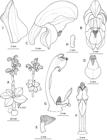

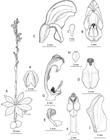

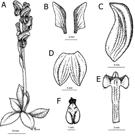

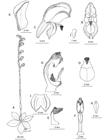



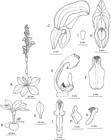


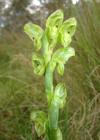
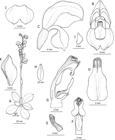

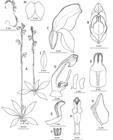


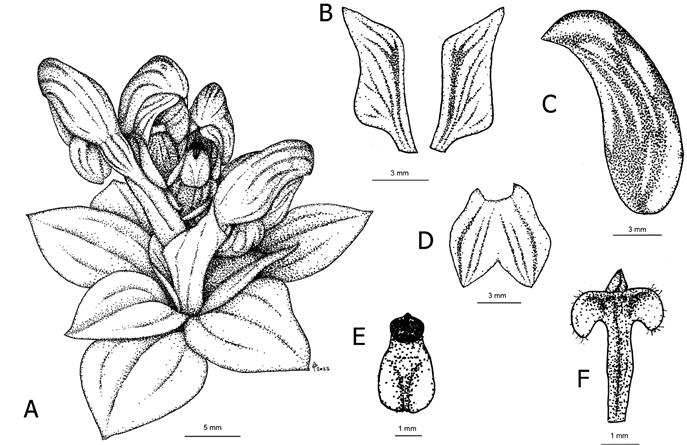 Illustration by Z. Groeneveld. Mokota Grassland Reserve SA, R. Bates 57244, 25 Aug. 2000.A. Habit. B. Petals. C. Flower, side view. D. Synsepal. E. Labellum flattened, from above. F. Column, front view.
Illustration by Z. Groeneveld. Mokota Grassland Reserve SA, R. Bates 57244, 25 Aug. 2000.A. Habit. B. Petals. C. Flower, side view. D. Synsepal. E. Labellum flattened, from above. F. Column, front view.
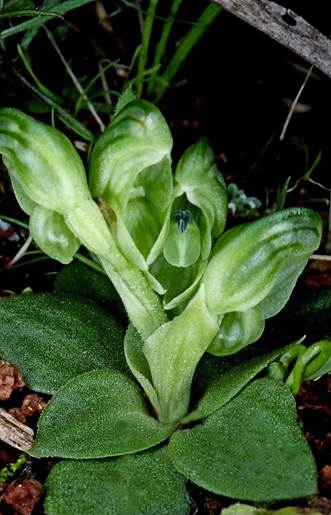 Photo by R. Bates.
Photo by R. Bates.
 Illustration by D. Jones. Woodchester SA, R. Bates 20422, 9 Sep. 1989.A. Habit. B. Flower, front view. C. Flower, side view. D. Labellum flattened, from above. E. Labellum appendage, side view. F. Column, front view. G. Column and labellum, side view. H. Pollinium. I. Petal.
Illustration by D. Jones. Woodchester SA, R. Bates 20422, 9 Sep. 1989.A. Habit. B. Flower, front view. C. Flower, side view. D. Labellum flattened, from above. E. Labellum appendage, side view. F. Column, front view. G. Column and labellum, side view. H. Pollinium. I. Petal.
 Photo by J. Niejalke.
Photo by J. Niejalke.
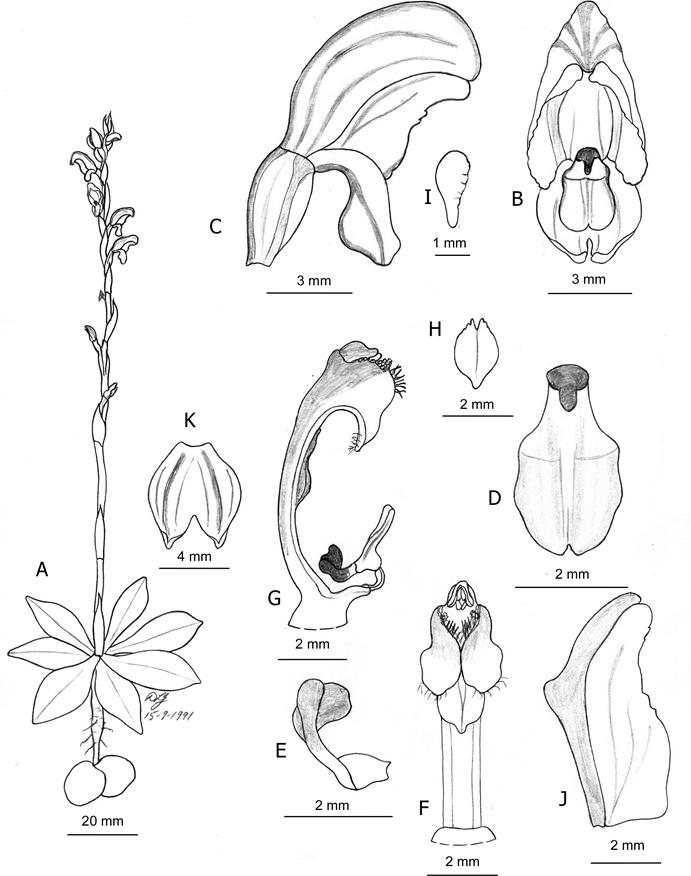 Illustration by D. Jones. Kangarooby NSW, cult H. Richards ex D.L. Jones collection, 15 Sep. 1991.A. Habit. B. Flower, front view. C. Flower, side view. D. Labellum flattened, from above. E. Labellum appendage, side view. F. Column, front view. G. Column and labellum, side view. H. Stigma. I. Pollinium. J. Petal. K. Synsepal.
Illustration by D. Jones. Kangarooby NSW, cult H. Richards ex D.L. Jones collection, 15 Sep. 1991.A. Habit. B. Flower, front view. C. Flower, side view. D. Labellum flattened, from above. E. Labellum appendage, side view. F. Column, front view. G. Column and labellum, side view. H. Stigma. I. Pollinium. J. Petal. K. Synsepal.
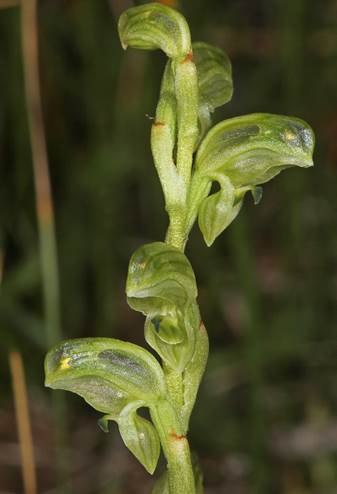 Photo by G. Back- house
Photo by G. Back- house
 Illustration by Z. Groeneveld. Carapee Rock SA, DLJ 17379, 6 Sep. 2000.A. Habit. B. Petals. C. Flower from side. D. Synsepalum. E. Column from front. F. Labellum flattened, from above.
Illustration by Z. Groeneveld. Carapee Rock SA, DLJ 17379, 6 Sep. 2000.A. Habit. B. Petals. C. Flower from side. D. Synsepalum. E. Column from front. F. Labellum flattened, from above.
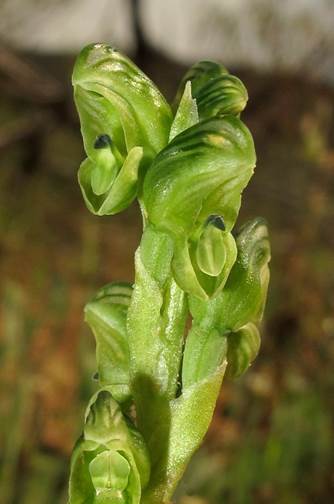 Photo by J. Niejalke.
Photo by J. Niejalke.
 Illustration by D. Jones. Texas Qld, R. Crane1439, 13 Oct. 1995.A. Habit. B. Flower from front. C. Flower from side. D. Labellum flattened, from above. E. Labellum appendage from side. F. Column from front. G. Column and labellum from side. H. Stigma. I. Pollinium. J. Synsepalum. K. Petal.
Illustration by D. Jones. Texas Qld, R. Crane1439, 13 Oct. 1995.A. Habit. B. Flower from front. C. Flower from side. D. Labellum flattened, from above. E. Labellum appendage from side. F. Column from front. G. Column and labellum from side. H. Stigma. I. Pollinium. J. Synsepalum. K. Petal.
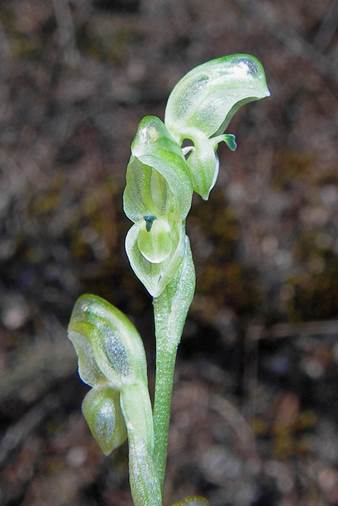 Photo by L. Copeland.
Photo by L. Copeland.
 Illustration by D. Jones. Mt Currumbenya NSW, D.L. Jones s.n., 9 Sep. 1995.A. Habit. B. Rosette leaf. C. Flower, side view. D. Flower, front view. E. Labellum flattened, from above. F. Labellum appendage, side view. G. Column and labellum, side view. H. Column, front view. I. Internal view of column wing and barrier trichomes. J. Stigma. K. Pollinium. L. Petal. M. Synsepal.
Illustration by D. Jones. Mt Currumbenya NSW, D.L. Jones s.n., 9 Sep. 1995.A. Habit. B. Rosette leaf. C. Flower, side view. D. Flower, front view. E. Labellum flattened, from above. F. Labellum appendage, side view. G. Column and labellum, side view. H. Column, front view. I. Internal view of column wing and barrier trichomes. J. Stigma. K. Pollinium. L. Petal. M. Synsepal.
 Photo by L. Copeland.
Photo by L. Copeland.
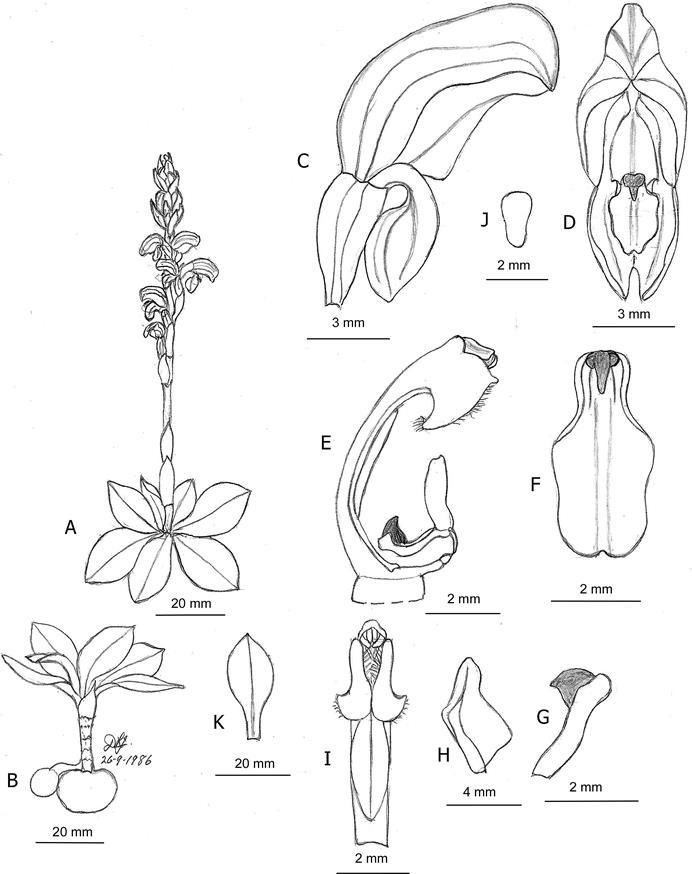 Illustration by D. Jones. Tailem Bend SA, M.A. Clements s.n., 26 Sep. 1986.A. Habit. B. Rosette. C. Flower, side view. D. Flower, front view. E. Column and labellum, side view. F. Labellum flattened, from above. G. Labellum appendage, side view. H. Petal. I. Column, front view. J. Pollinium. K. Rosette leaf.
Illustration by D. Jones. Tailem Bend SA, M.A. Clements s.n., 26 Sep. 1986.A. Habit. B. Rosette. C. Flower, side view. D. Flower, front view. E. Column and labellum, side view. F. Labellum flattened, from above. G. Labellum appendage, side view. H. Petal. I. Column, front view. J. Pollinium. K. Rosette leaf.
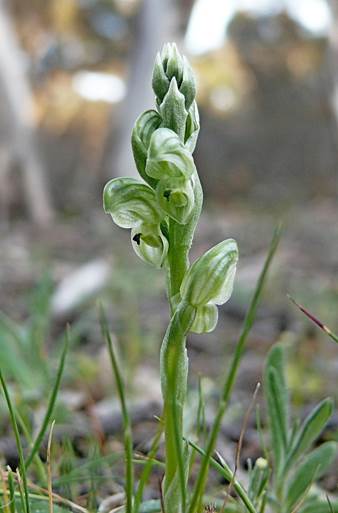 Photo by J. Niejalke.
Photo by J. Niejalke.
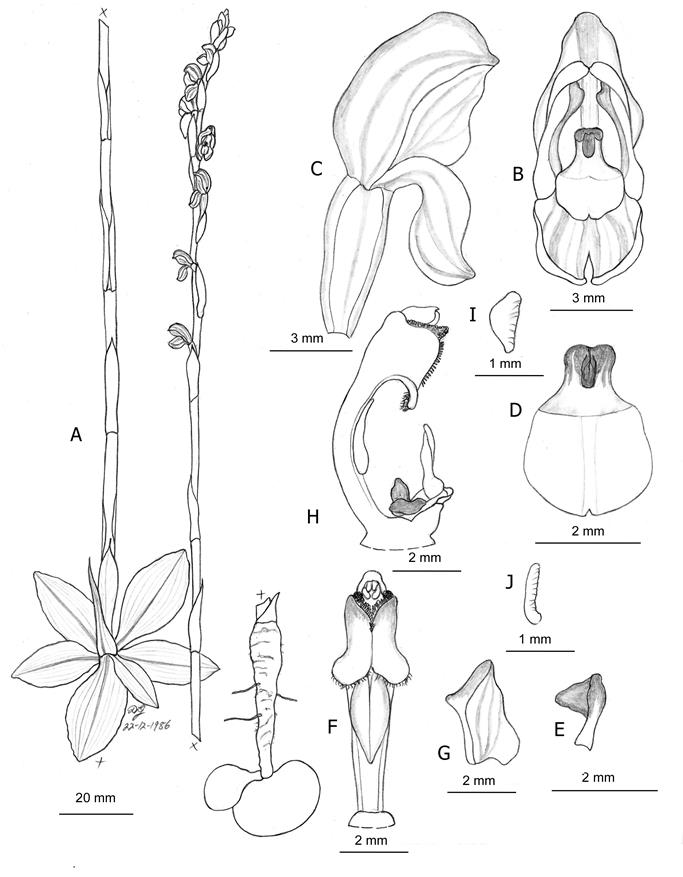 Illustration by D. Jones. Barrington Tops NSW, R.G. Tunstall s.n., 22 Dec. 1986.A. Habit. B. Flower, front view. C. Flower, side view. D. Labellum flattened, from above. E. Labellum appendage, side view. F. Column, front view. G. Petal. H. Column and labellum, side view. I-J. Pollinia from different anther cells.
Illustration by D. Jones. Barrington Tops NSW, R.G. Tunstall s.n., 22 Dec. 1986.A. Habit. B. Flower, front view. C. Flower, side view. D. Labellum flattened, from above. E. Labellum appendage, side view. F. Column, front view. G. Petal. H. Column and labellum, side view. I-J. Pollinia from different anther cells.
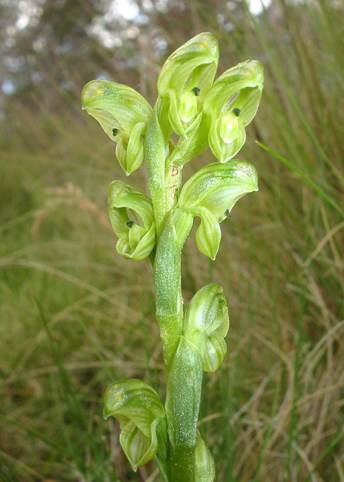 Photo by L. Copeland.
Photo by L. Copeland.
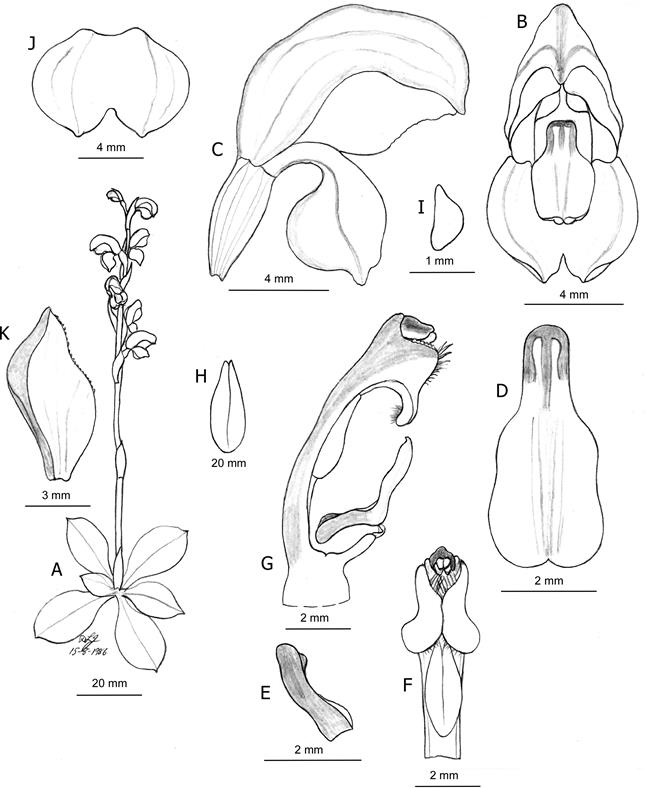 Illustration by D. Jones. Flinders Ra. SA, cult H. Richards, 15 Aug. 1996.A. Habit. B. Flower, front view. C. Flower, side view. D. Labellum flat- tened, from above. E. Labellum appendage, side view. F. Column, front view. G. Column and labellum, side view. H. Stigma. I. Pollinium. J. Synsepal. K. Petal.
Illustration by D. Jones. Flinders Ra. SA, cult H. Richards, 15 Aug. 1996.A. Habit. B. Flower, front view. C. Flower, side view. D. Labellum flat- tened, from above. E. Labellum appendage, side view. F. Column, front view. G. Column and labellum, side view. H. Stigma. I. Pollinium. J. Synsepal. K. Petal.
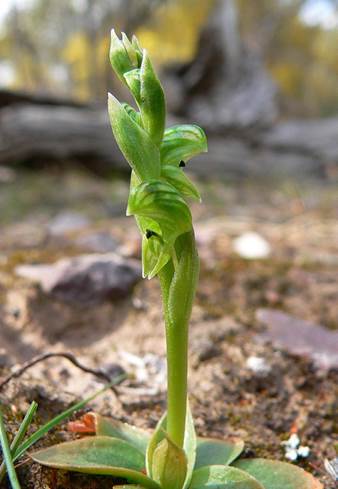 Photo by J. Niejalke.
Photo by J. Niejalke.
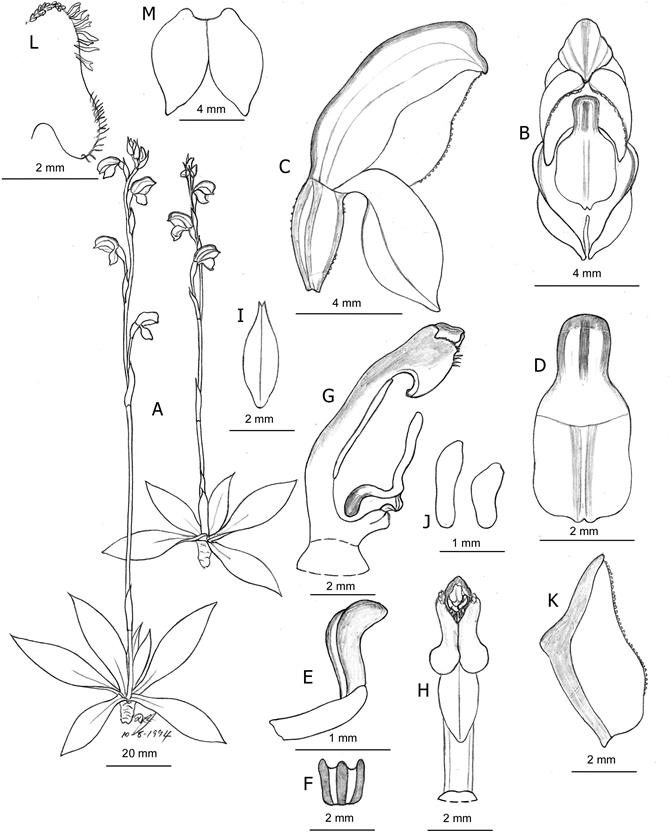 Illustration by D. Jones. Lake Grace WA, C.J. French, 10 Aug. 1994.A. Habit. B. Flower, front view. C. Flower, side view. D. Labellum flattened, from above. E. Labellum appendage, side view. F. Labellum appendage grooves. G. Column and labellum, side view. H. Column, front view. I. Stigma. J. Pollinia from different anther cells. K. Petal. L. Internal view of column wing. M. Synsepal.
Illustration by D. Jones. Lake Grace WA, C.J. French, 10 Aug. 1994.A. Habit. B. Flower, front view. C. Flower, side view. D. Labellum flattened, from above. E. Labellum appendage, side view. F. Labellum appendage grooves. G. Column and labellum, side view. H. Column, front view. I. Stigma. J. Pollinia from different anther cells. K. Petal. L. Internal view of column wing. M. Synsepal.
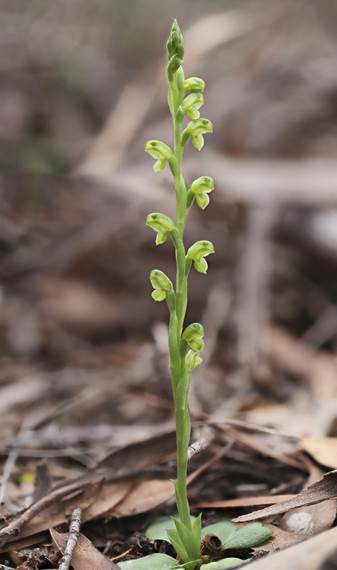 Photo by J. Niejalke.
Photo by J. Niejalke.